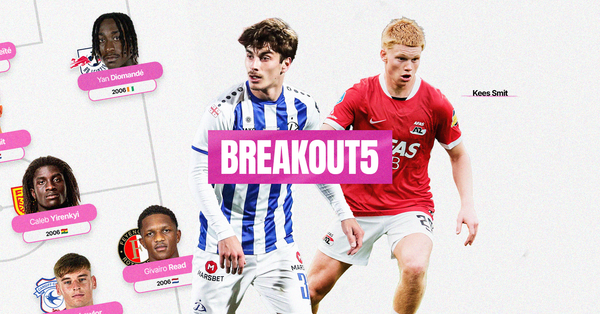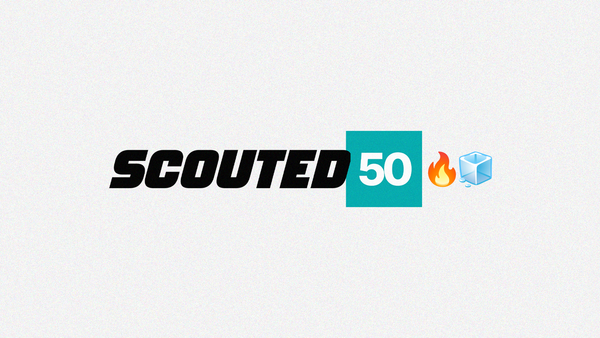Profiling Europe's Most Wanted Wingers
Wingfielders and wide-forwards analysed with Attributes and Archetypes
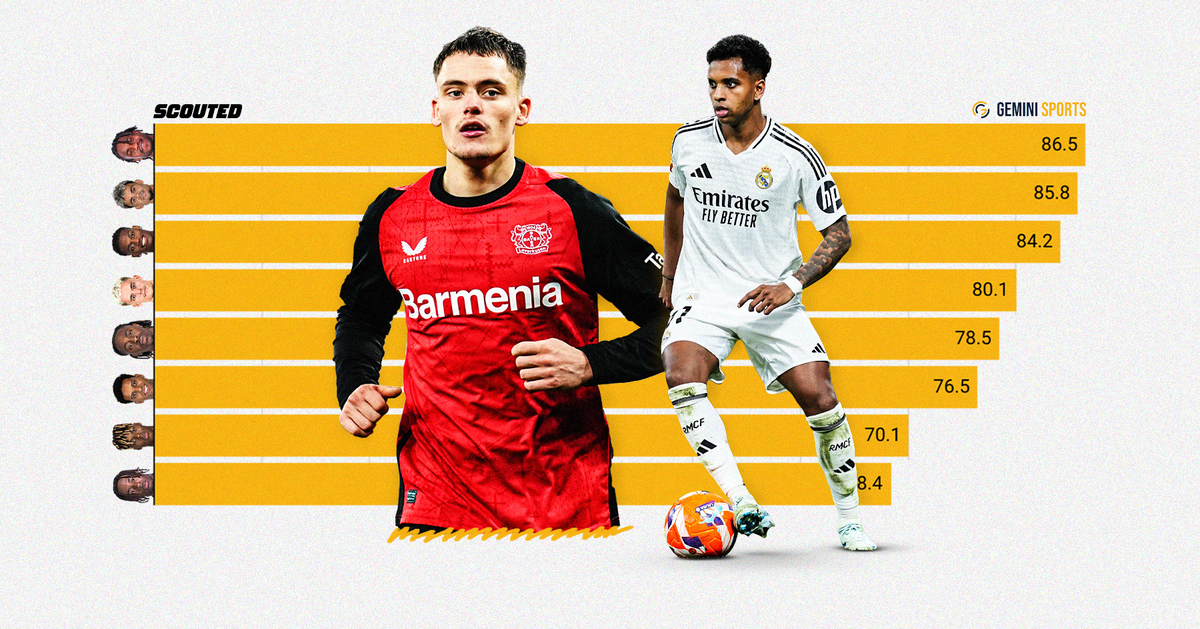
Wingers are more diverse than ever.
The traditional variant, the up-and-down speed demons that blast past full-backs before crossing the ball into the box, still exist - in SCOUTED Archetype lingo, these are the Roadrunners.
Then there are the Raiders, wide forwards laser-focused on arriving into optimal goalscoring positions to tap in crosses. There are Safecrackers, wide playmakers who drift in from their designated flank to break open the deepest and most robust blocks with their passing. And then, at the centre of this spectrum are the elite, match-winning Archetypes.
It’s no longer rare to see a player controlling the game while roaming from wing to wing with an almost-perfect balance between running, passing and carrying. These are the Gameweavers, omnipresent, omnipotent, the modern reimagining of the number ten.
And finally, the Gamebreakers. These wide forwards are single-minded in their approach to smashing through the last line of defence. Whether creating opportunities for themselves or putting it on a plate for others, the Gamebreaker is a relentless button-mashing threat addicted to cold hard goals and assists.
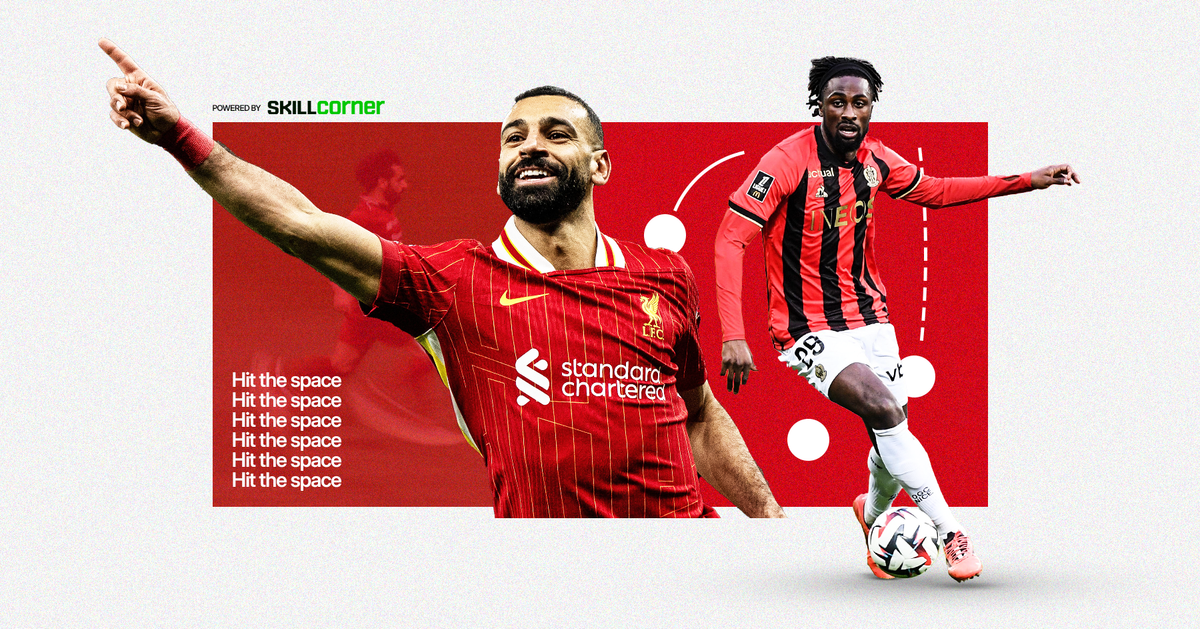
The increasing variety of roles adopted by wide players and the proliferation of the term ‘wingfielder’ - which you may have come across in Billy Carpenter’s winger scouting odyssey - has led me to include them in a bucket with attacking midfielders.
But a bucket isn’t much use to anyone. We need to sort through it, and distinguish the Archetypes from one another. We want to build data profiles scouts can use to spot the player their team needs - then use them to answer the most pressing questions we have about wingers today.
To do so we must define each Archetype’s Superpower - the heart of what they do on the pitch better than any other player, and the key to distinguishing them. Working alongside Gemini Sports, we have mapped our collection of winger’s Superpowers to the following Attributes:
- Shot Location
- Shot Placement
- Passing
- Carrying
- Dribbling
- Pressing
- Aerial
This article was produced under a commercial collaboration with Gemini Sports. Gemini helps elite football front offices streamline roster management with intuitive, customizable, AI-powered workflows, all in one single source of truth for their different information streams. Gemini's next-gen command centre for Squad Planning and Player Trading makes scouting reports & data feeds alike smarter, synchronised, and as simple to use as Spotify at clubs worldwide.
We're incredibly grateful to our partners, whose support helps keep SCOUTED afloat.
For those who missed the Most Wanted Striker profiles, we’ll score each player profiled out of 100 for each of the above Attributes, based on their output over the past three seasons. An Archetype Score is then calculated according to a custom weighting for each Attribute.
As a result, every player receives a 0-100 rating for each of the five Winger Archetypes: Raider, Safecracker, Roadrunner, Gameweaver and Gamebreaker. Here is a breakdown of those weightings; the hope is a Poster Boy for each pops into your head immediately.
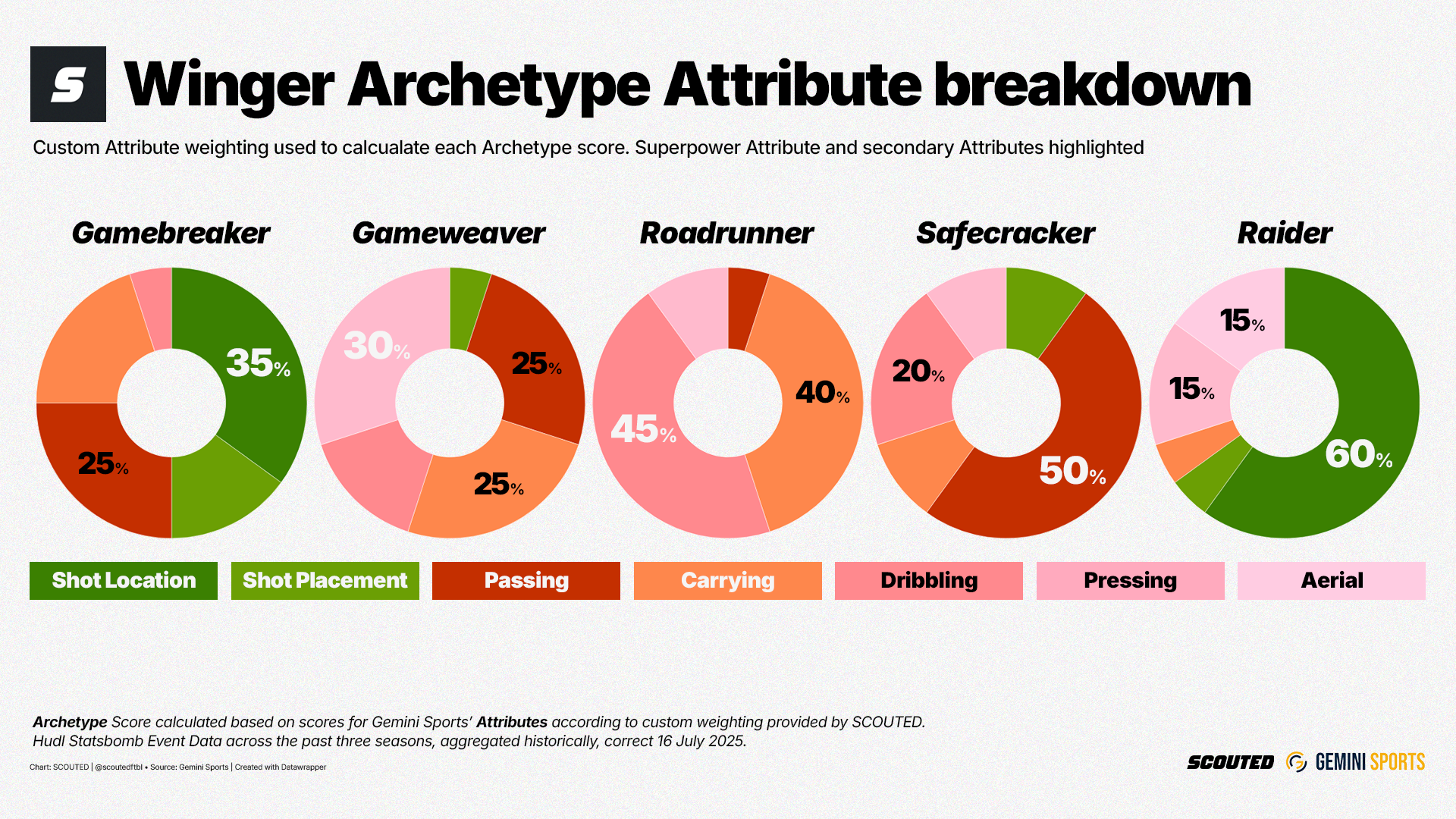
As I did with strikers, I have selected eight wide players that have dominated this summer’s discourse. Below, you’ll find their rankings for all five Archetypes alongside their Gemini Player Rating (GPR), a league-adjusted 0-100 metric that evaluates how above-average a player is when compared to others in the same position. For context, the only two wingers / attacking midfielders that score above 90 GPR are Mohamed Salah (92.9) and Ousmane Dembélé (90.6), the Ballon d’Or favourites.
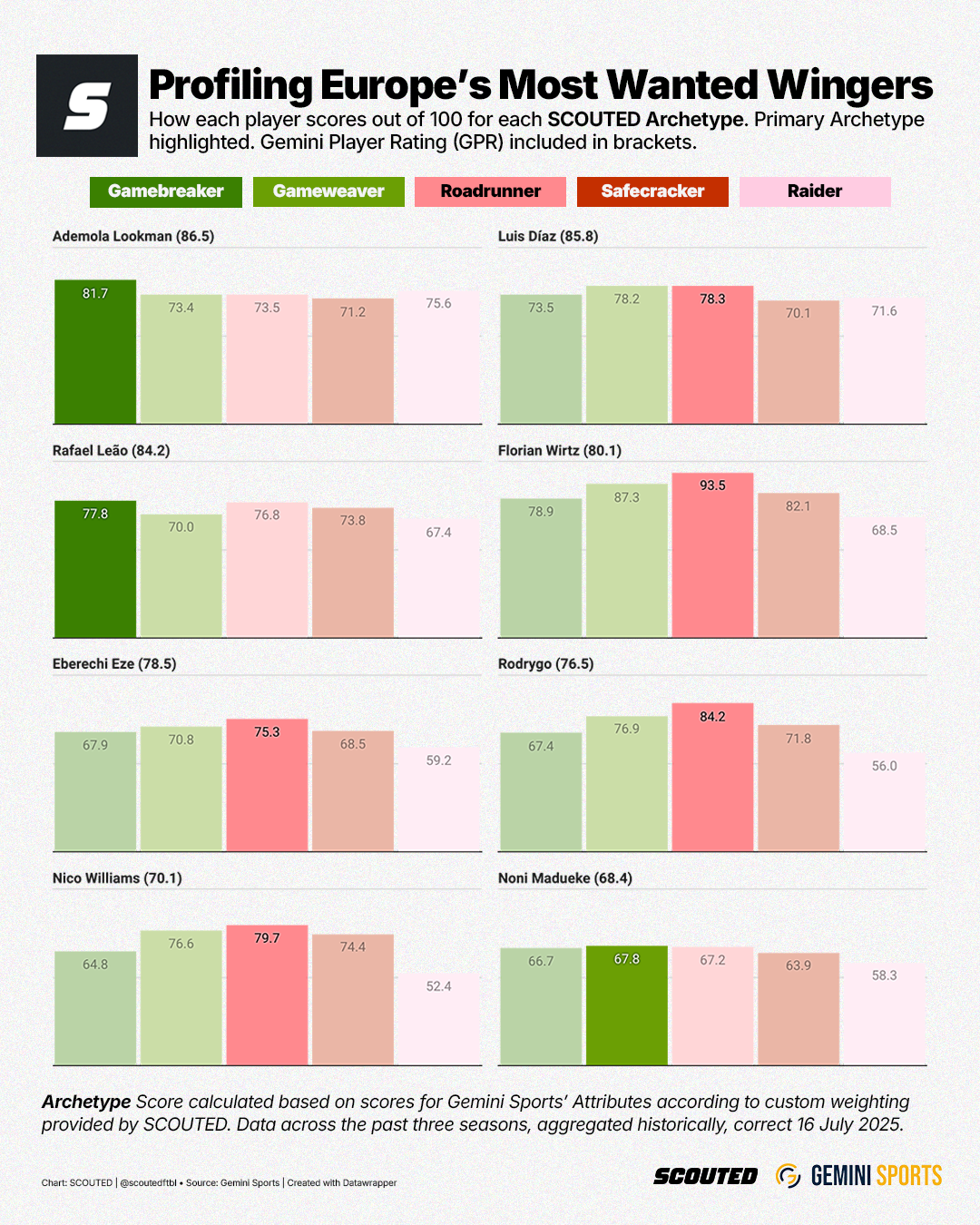
Profiling the wingers in the transfer window zeitgeist will help develop a better understanding of each Archetype. So, in this article, I am going to answer the following questions about each player:
- Why did Florian Wirtz cost €134m?
- Why does no one want Rafael Leão?
- Why did everyone want Nico Williams?
- Why do Bayern want Luis Díaz so badly?
- Why is Rodrygo available?
- Why have Arsenal signed Noni Madueke?
- Why do Arsenal and Chelsea want Eberechi Eze?
- Why do Inter have a free run at Ademola Lookman?
Let’s get stuck in.

Why did Florian Wirtz cost €134m?
It shouldn’t take long to work out why Bayern, Manchester City and Liverpool all wanted Florian Wirtz, and why he became a Premier League record transfer. He is the highest-scoring player within this group for three out of the five Archetypes: Gameweaver, Roadrunner and Safecracker.
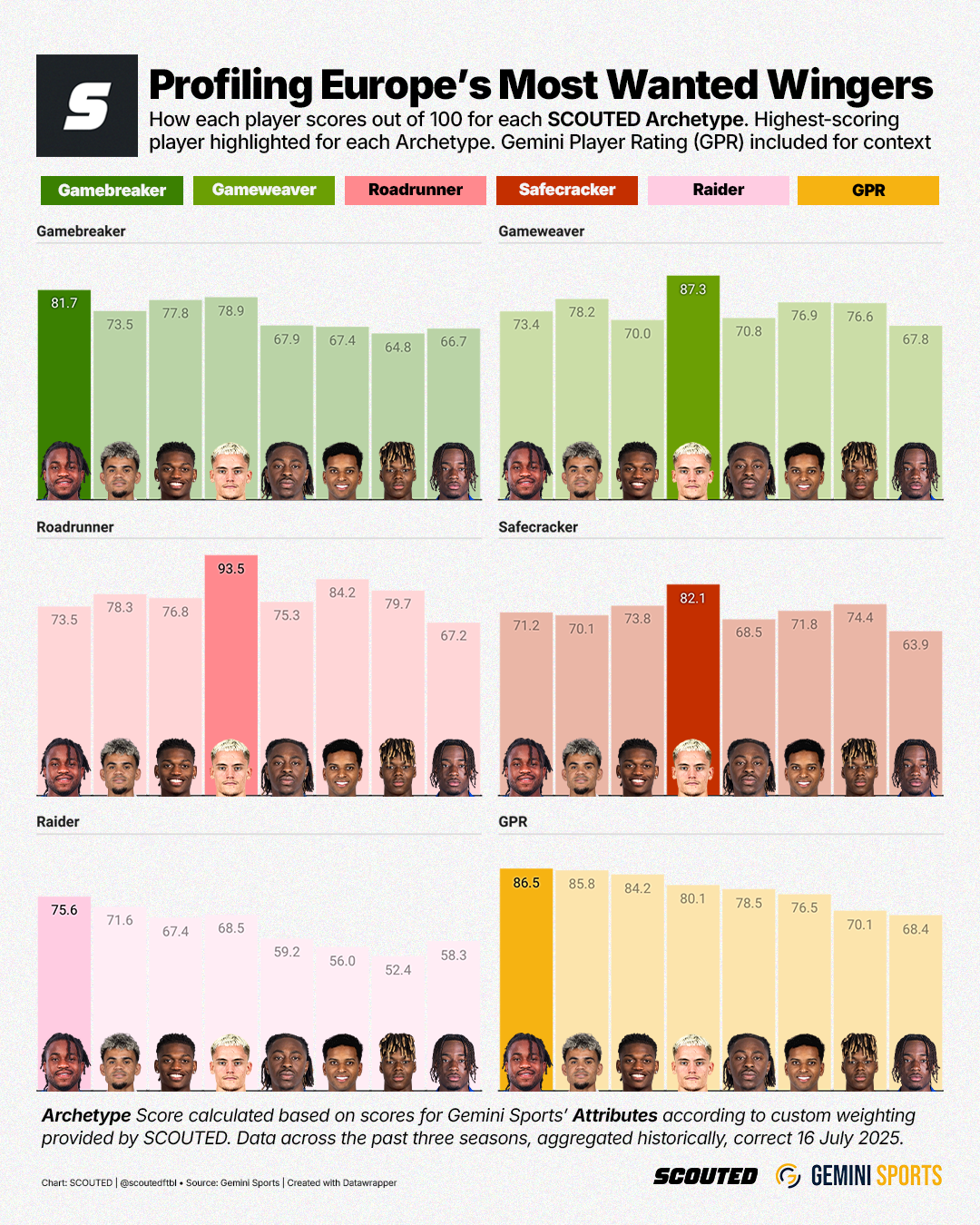
While he ranks first for four out of the eight Attributes that make up the Archetype Score: Shot Placement, Carrying, Dribbling and Pressing.
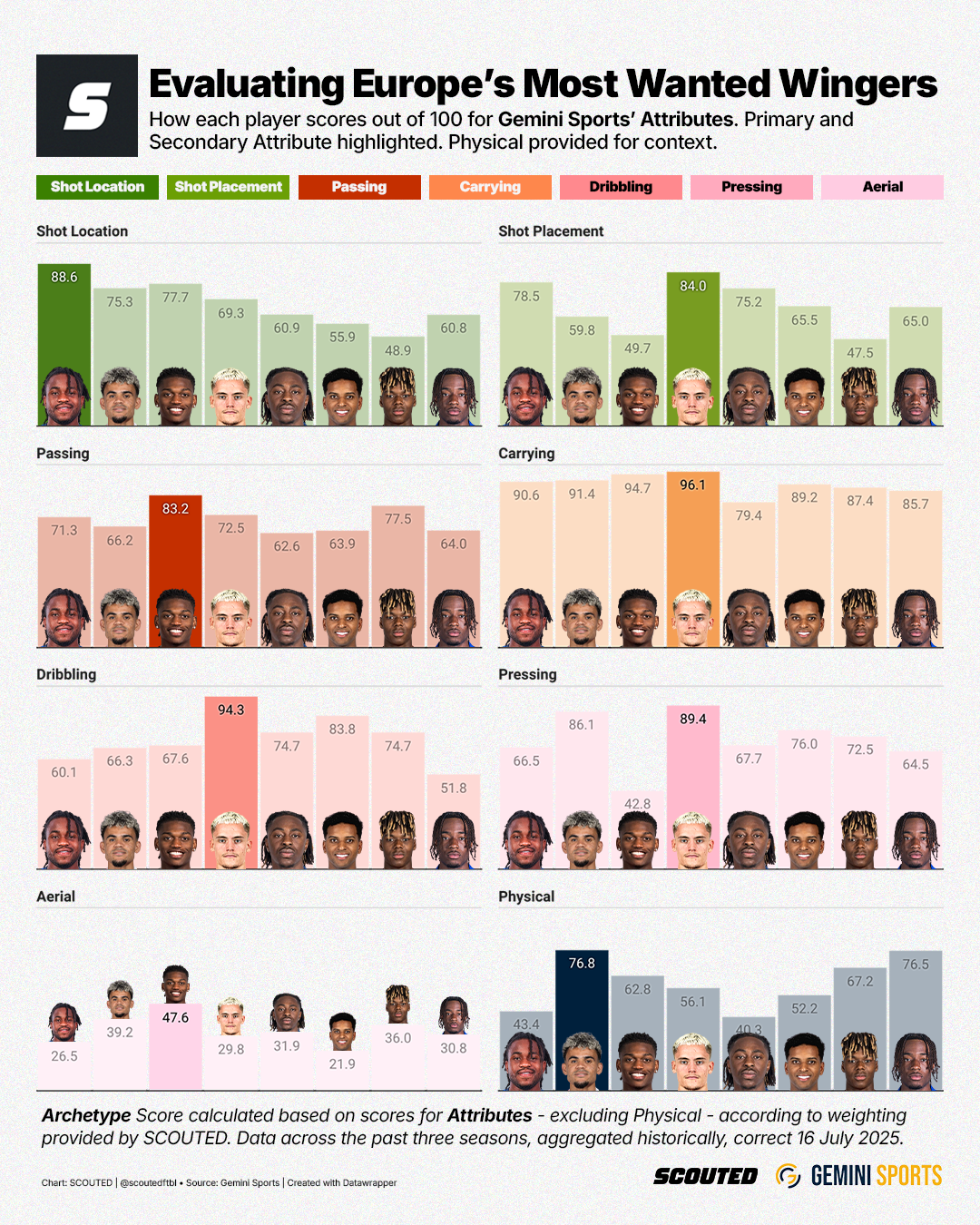
Simply put, Wirtz is a world-class player. However, the German’s Archetype and Attribute Scores introduce an important point: the Roadrunner and Gameweaver profiles would be separated further by Physical Scores.
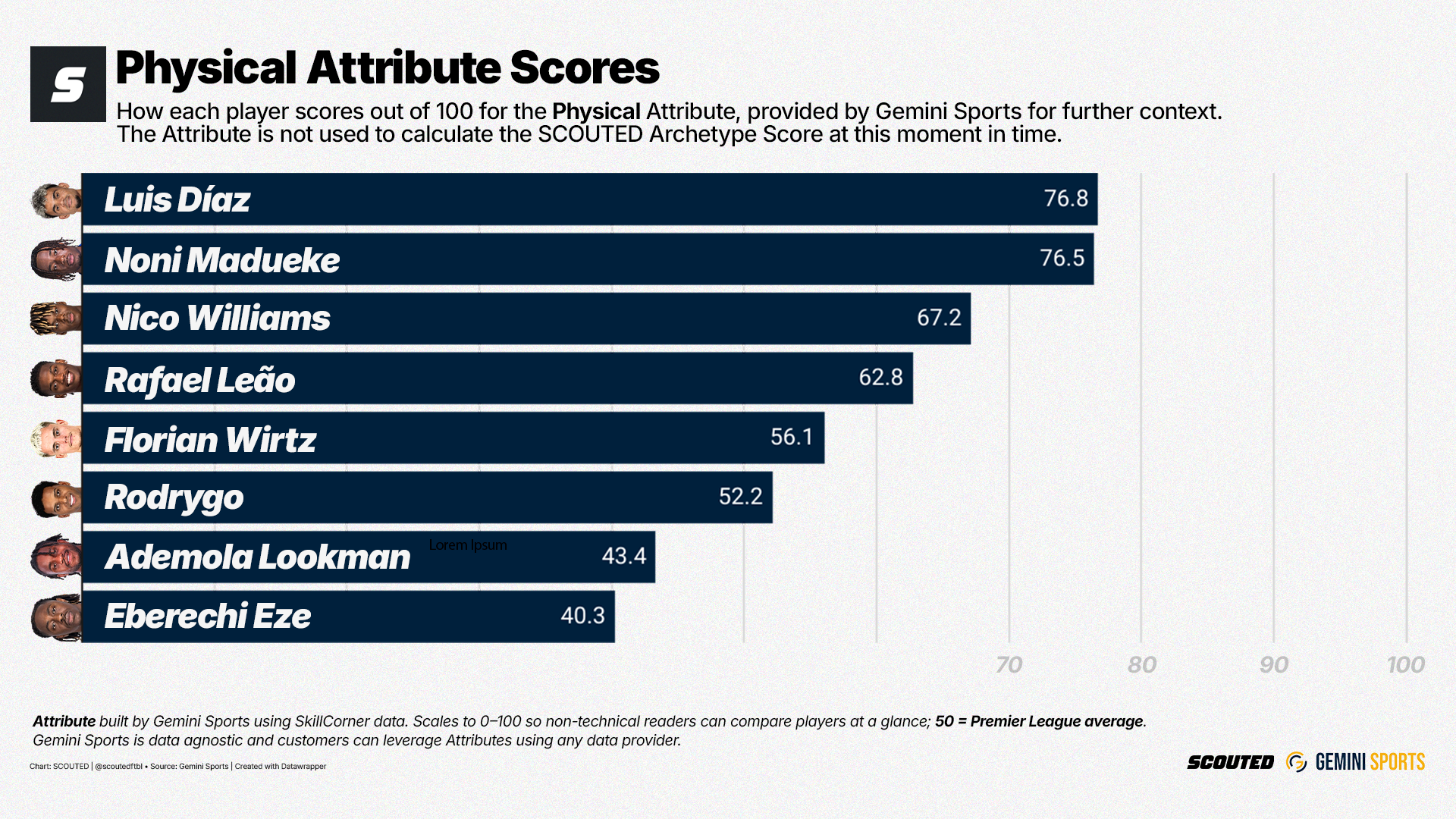
Straight away, the potential Primary Archetype shifts become obvious. Although Wirtz ranks above the Premier League average, his Score might push him into the Gameweaver bucket - he was the inspiration for that Archetype, after all. I previously referred to it as the Omni-ten.
🔋 Learn more about Gemini Sports' Physical Score
Rough Intensity Bands (rule-of-thumb)
- 80–100: Exceptional sustained/high-intensity running relative to PL. Likely to meet or exceed demands in up-tempo pressing systems.
- 65–79: Strong physical contributor; comfortably above PL average.
- 50–64: Around PL average to modestly above.
- 35–49: Below PL average; could still fit roles with positional conservation (e.g., some CB profiles) or tactical systems that protect workload.
- 0–34: Well below PL average or very low-minute / role-protected players; inspect context (sample size, match state, recent injury).
Context matters:
- Minutes played: Low minutes can distort per-minute intensity measures.
- Role / position: Wide players and box-to-box mids typically score higher; central defenders often lower without being under-fit.
- League style: High-tempo leagues inflate relative expectations; slower leagues deflate them.
- Match state: Chasing games vs. sitting in blocks affects running loads.
The same applies for Eze, whose Physical Score is the lowest in our dataset. Conversely, Madueke’s strong Physical Score would most likely move the needle towards the Roadrunner profile.
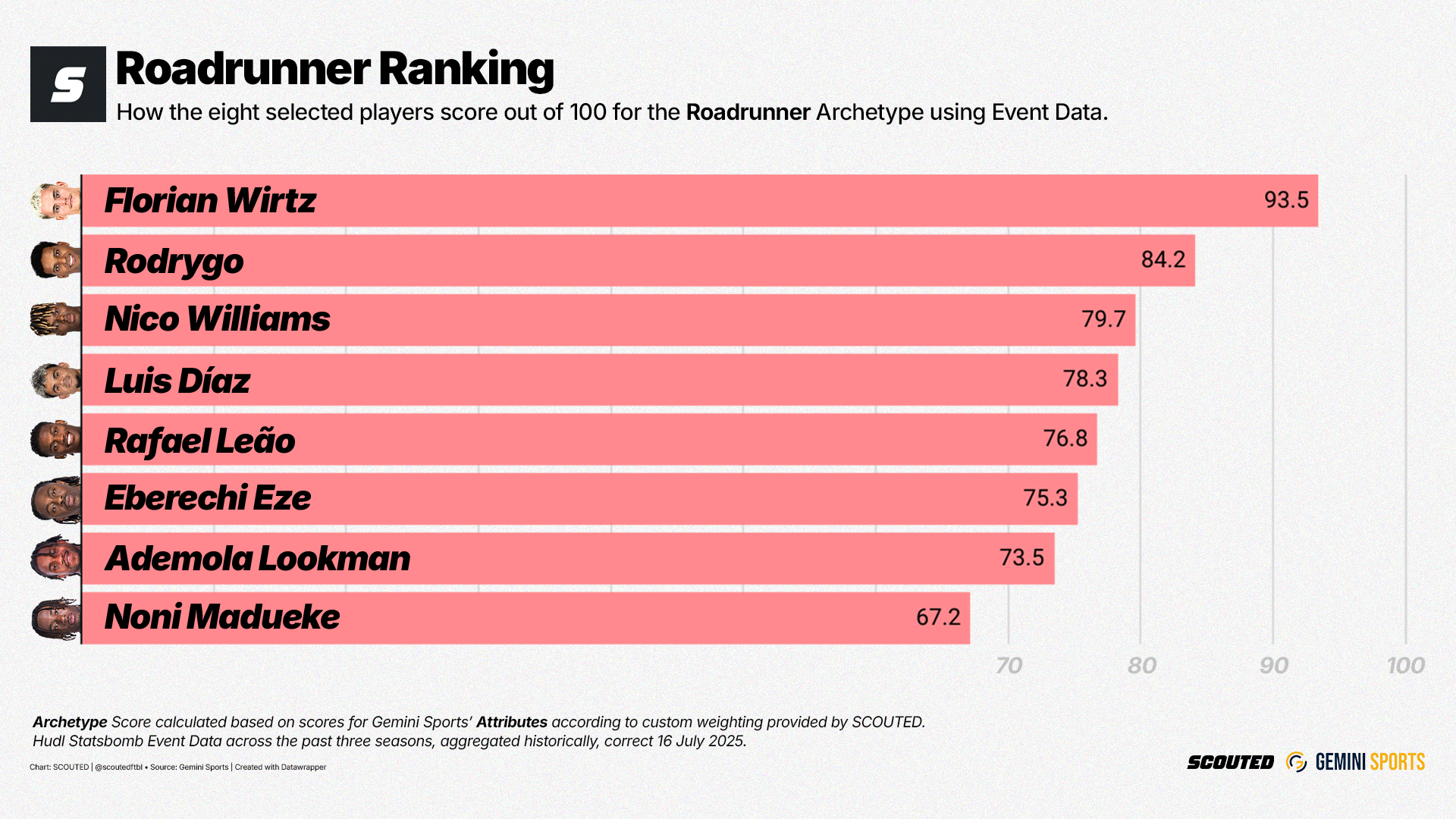
That being said, Wirtz’s incredible scores for the Roadrunner Archetype and its key Attributes should not be overlooked. In fact, they should be celebrated. Of the 4,655 players in the Winger / Attacking Midfielder database provided by Gemini Sports, only four score 90+ for both Attributes:
Vinícius Júnior (C: 100, D: 93.7)
Florian Wirtz (C: 96.1, D: 94.3)
Jérémy Doku (C: 95.2, D: 96.2)
Juan Brunetta (C: 93.3, D: 90.0)
What separates Wirtz from the pack is his 89.4 Pressing Attribute Score - 12.5 higher than Vinícius Júnior, the next best in that group. This Attribute will help us answer our next question.
Why does no one want Rafael Leão?
I have no idea. Well, that’s not exactly true. I know why. Take a look at the Pressing ranking for these eight players and you will, too.
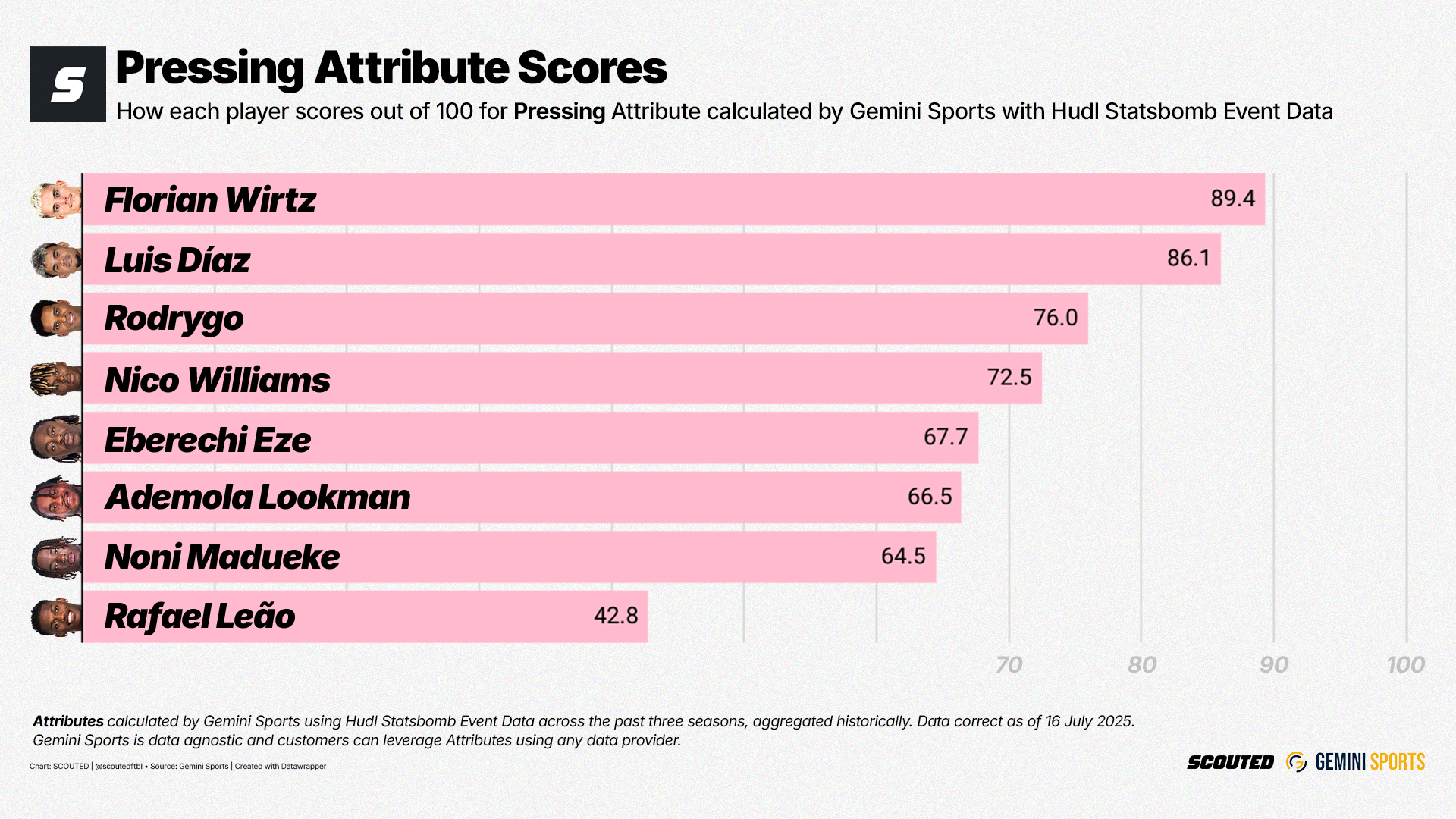
My argument? Leão’s shortcomings in the press shouldn’t matter, because he is the personification of the Gamebreaker profile. Not only does he rank first for Passing in this group - the only player to score above 80 - but he also ranked second behind Lookman for Shot Location. You’re not meant to be elite at both.
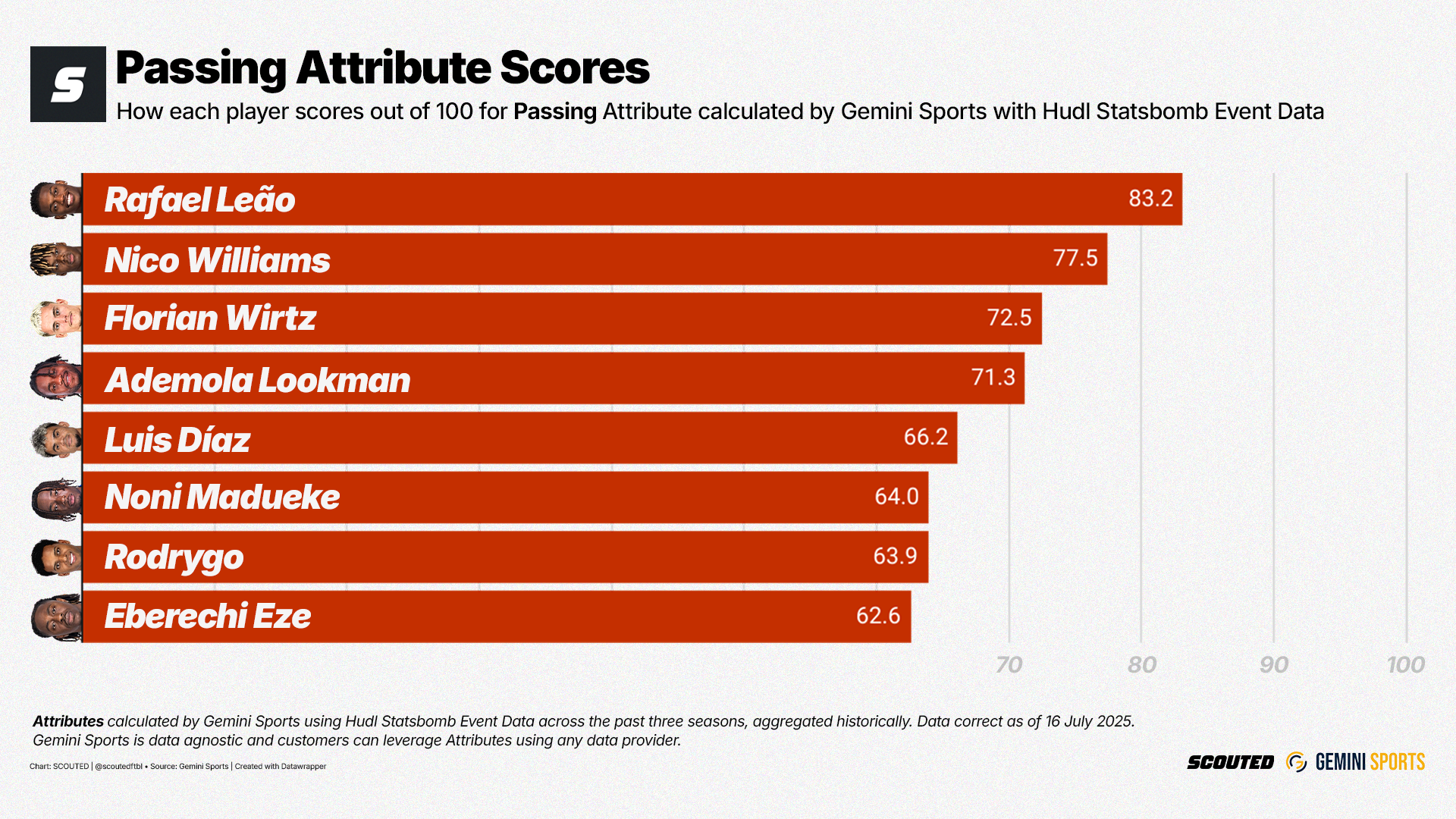
To hammer home the rarity of blending these two superpowers, I have another stat. Of the 4,655 players in the Winger / Attacking Midfielder database provided by Gemini Sports, only these six players scored 75+ for both the Shot Location and Passing Attributes:
Mohamed Salah (SL: 100, P: 96.1)
Raphinha (SL: 77.2, P: 90.7)
Rafael Leão (SL: 77.7, P: 83.2)
Ousmane Dembélé (SL: 76.8, P: 80.9)
Cole Palmer (SL: 75.4, P: 78.6)
Kaoru Mitoma (SL: 76.5, P: 77.1)
Of those six players, Rafael Leão ranks first for Carrying with 94.7 - only the €134m Wirtz beats him within our most wanted selection.
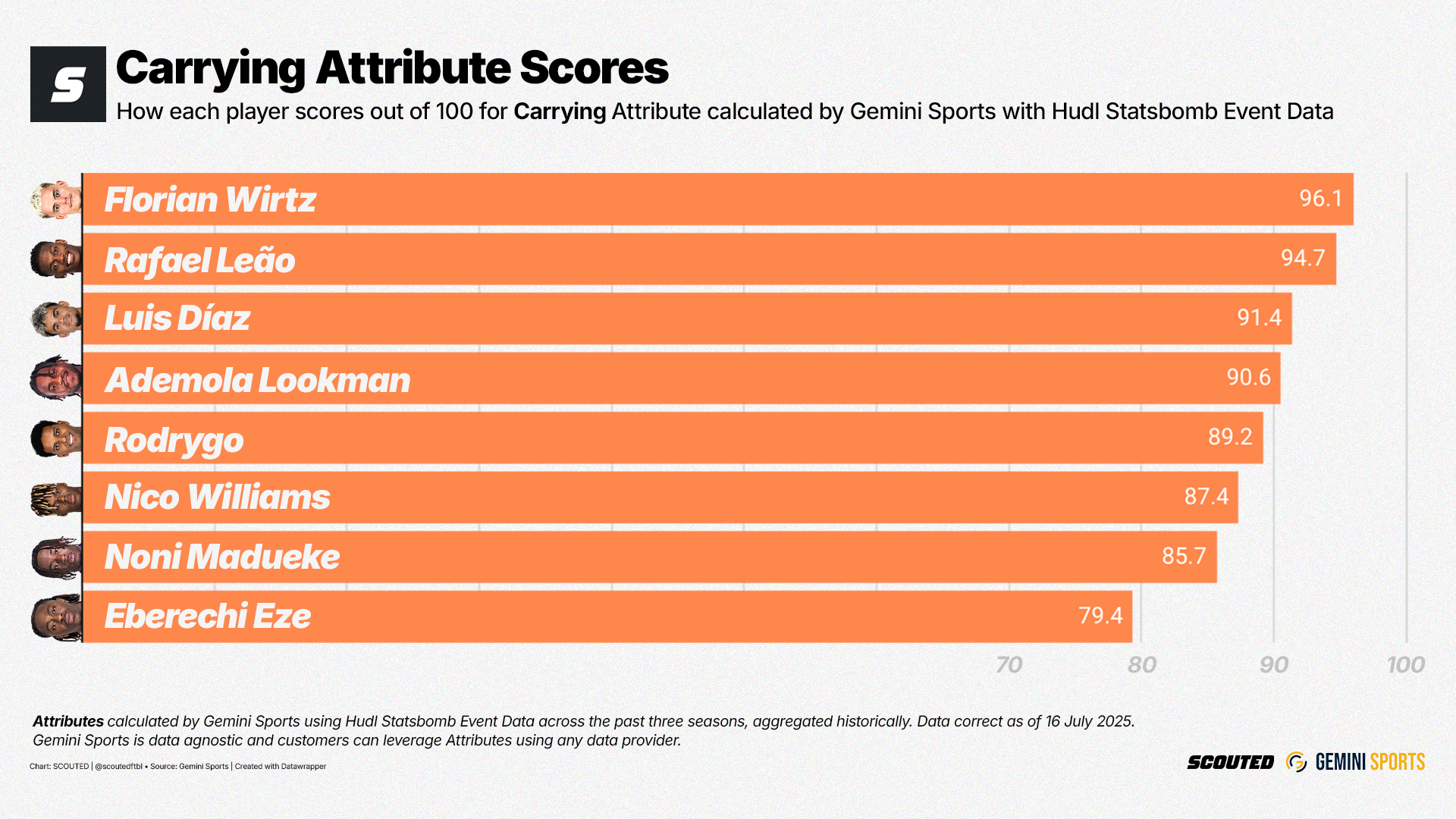
But, in the interest of balance, he is also the only player from that group of six that scores below 65 for Pressing. Even Salah, a player so productive you would not care what he did off the ball, scores 72.6. Therein lies the issue.
Personally, I think Leão’s Gamebreaking ability is so obvious I would pay the money. Throw in his cheat code athleticism - 1.88m tall and rapid - and you have a potential world-beater. But that’s just my opinion.
We have the answer to our Leão conundrum - and, as I’ll explain, to our next question too.
Why did everyone want Nico Williams?
Put simply, Nico Williams is pretty much Rafael Leão without the Pressing red flag. If we take another look at our eight players with their Primary and Secondary Attribute, you’ll see what I mean.
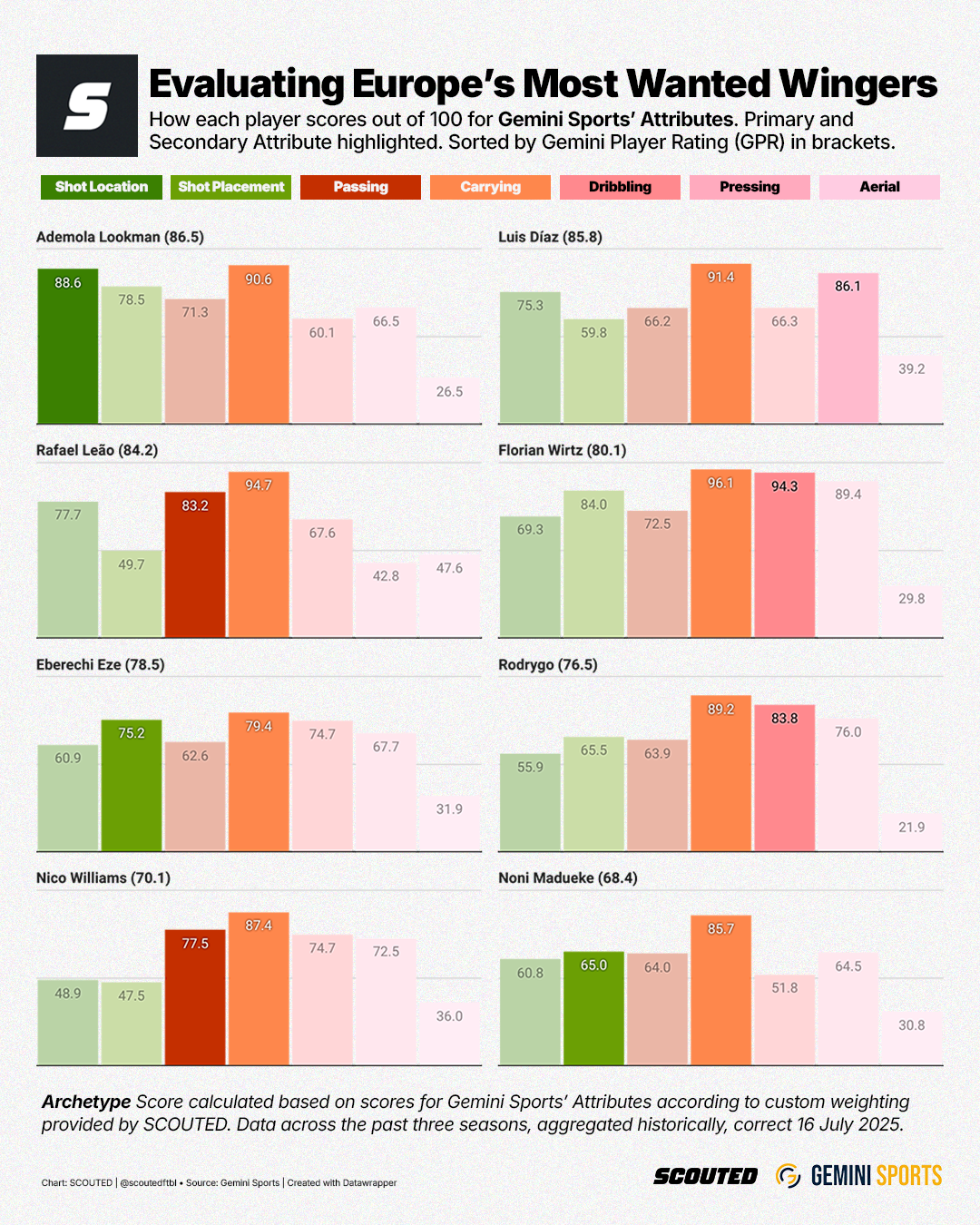
Leão and Williams are the only two players with Carrying and Passing as their Primary and Secondary Attributes, let alone in the same order. Again, Leão’s Shot Location Score is a huge green Gamebreaker flag for me - especially when compared to Williams - but you can see why clubs searching for that Roadrunner style would have enquired about Nico. FC Barcelona were the most notable suitors - a quick comparison with Raphinha and Lamine Yamal paints the picture.
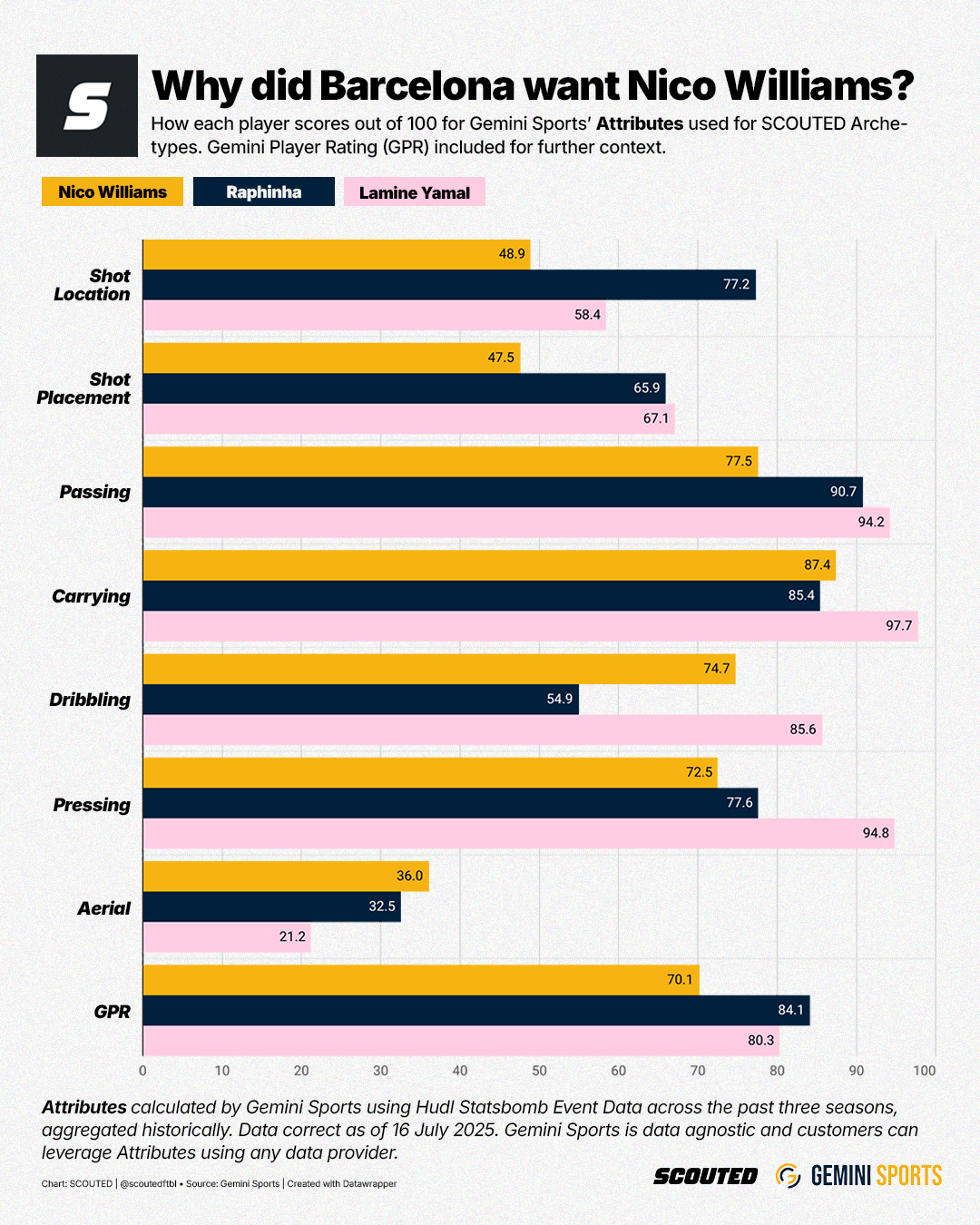
In Raphinha, they have the Leão qualities covered. Nico profiles more similarly to Yamal, and would have provided Barcelona the option to rest their new number ten without losing the trident of Carrying, Passing and Dribbling he provides, albeit from the opposite flank.
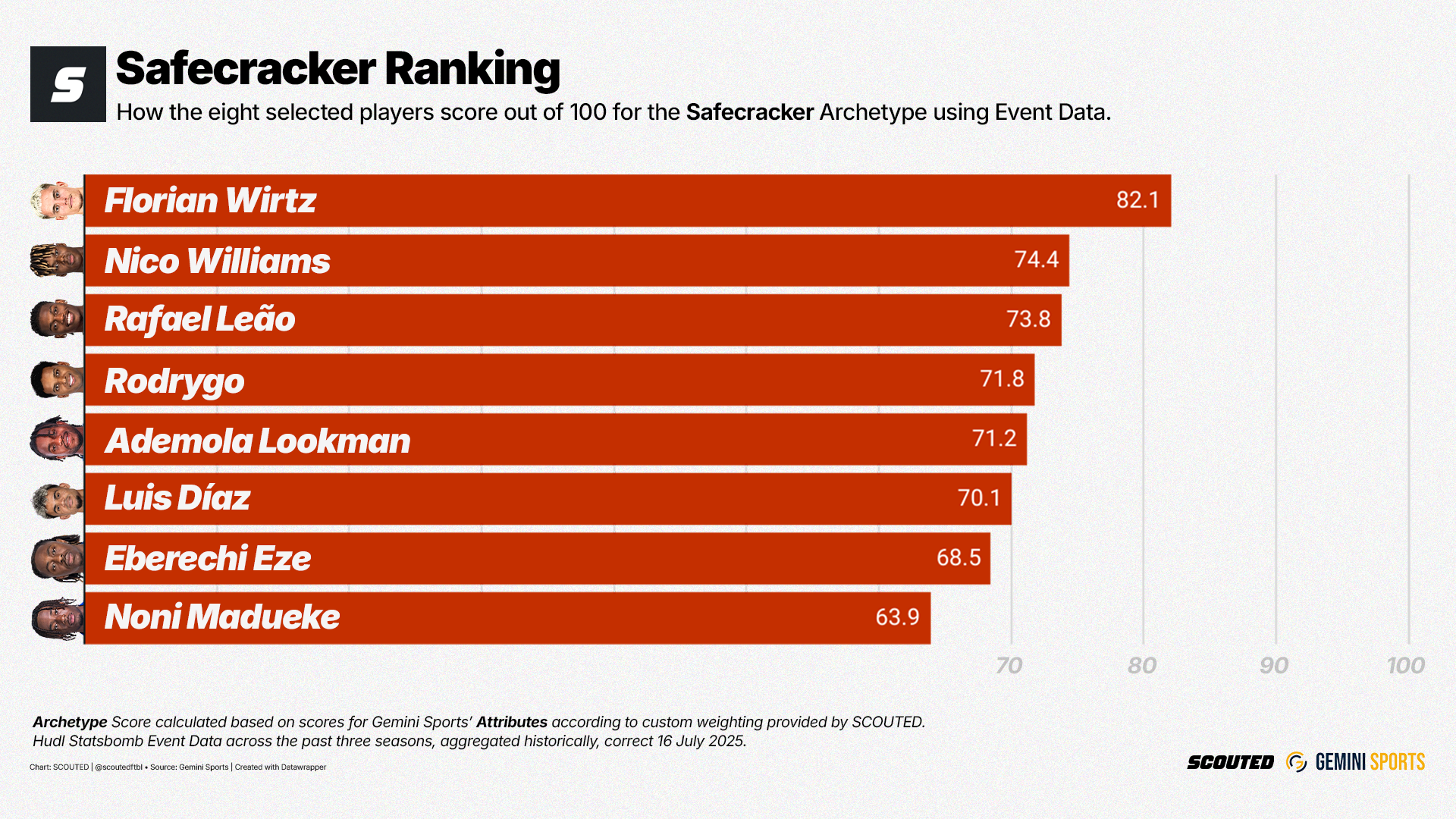
I imagine we would have seen Williams, Raphinha and Yamal in a PSG-style front three had he joined. Alas, Nico has signed a 10-year contract at his boyhood club and Barcelona are in the market for someone else.
Why do Bayern want Luis Díaz so badly?
David Ornstein’s report that Liverpool valued Luis Díaz at €100m was met with surprise and a bit of ridicule. I found the reaction bizarre at the time and it looks more so through the lens of Gemini Sports.
First of all, Díaz doesn’t just have the second-highest GPR in our group but the fourth-highest in the entire dataset. Only Salah, Dembélé and Ademola Lookman rank above him; Luis Díaz is one of the best wingers in the world right now. That’s why Bayern want him to be the significant wide upgrade they need.
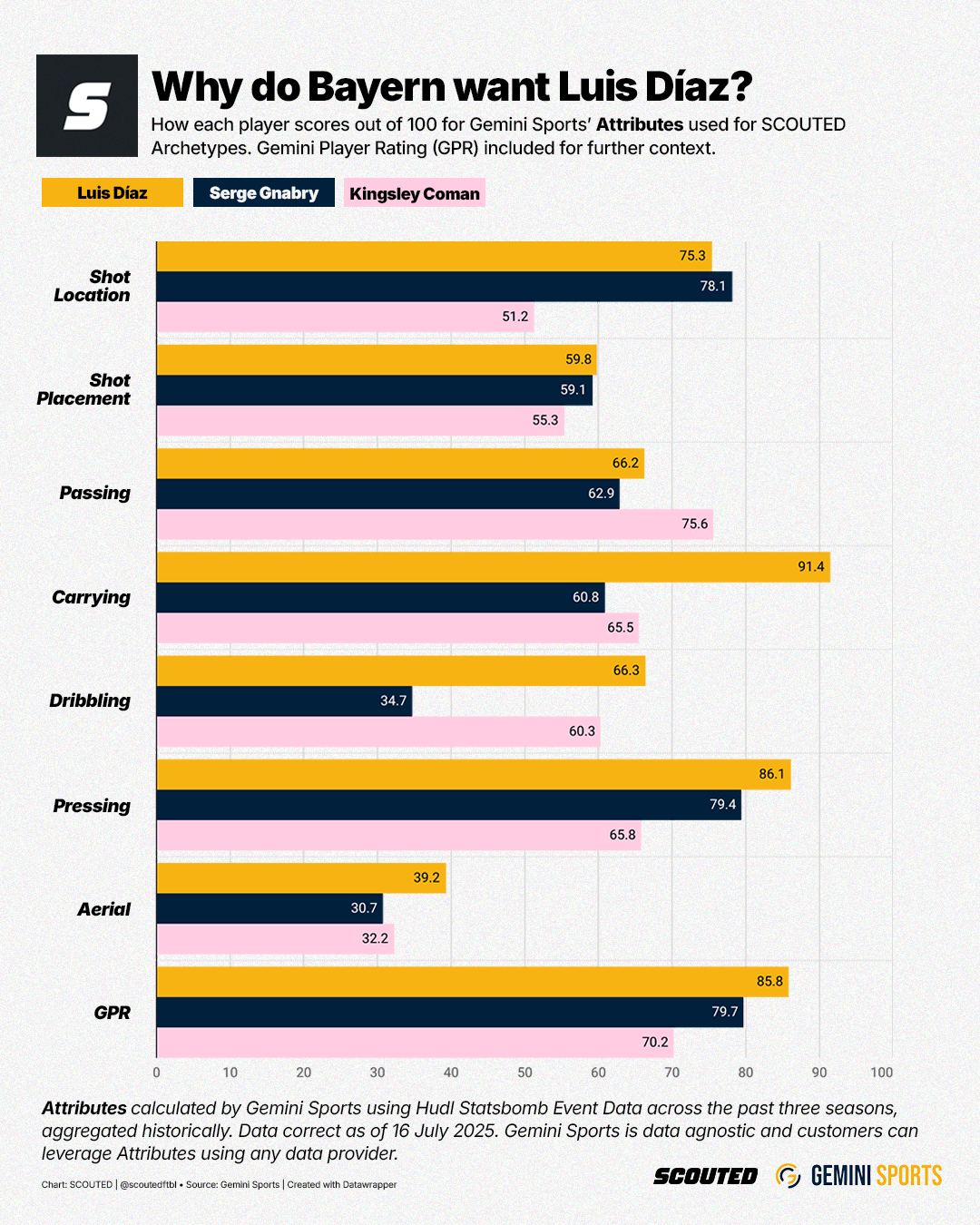
The Colombian matches Serge Gnabry and Kingsley Coman for their key Attributes while also bringing elite Pressing and world-class Carrying to the table. This becomes even more important when you consider the injury to Jamal Musiala.
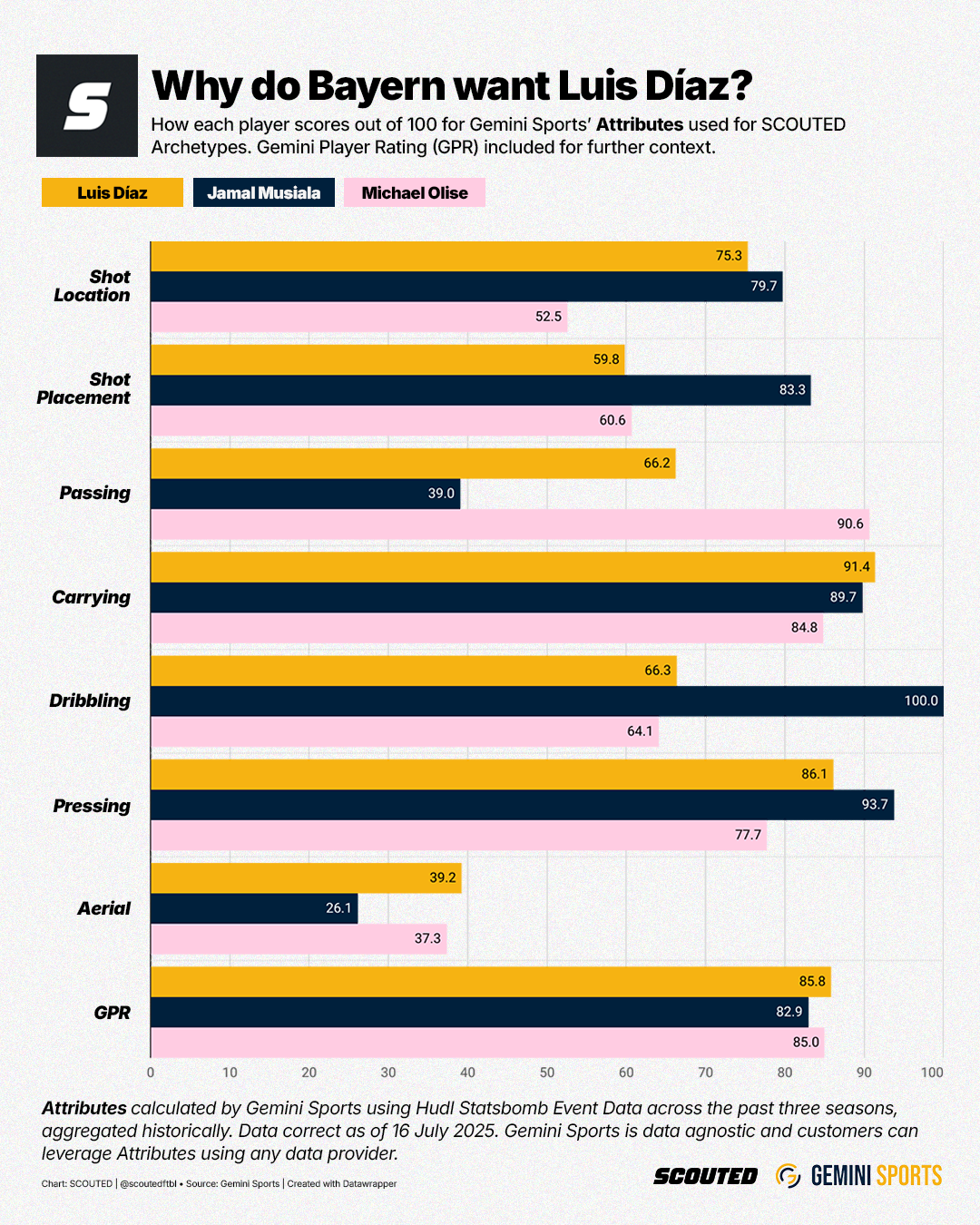
Based on his Shot Location score, Díaz would provide a reliable option for Olise’s Passing, just as he was for Salah. And although the Colombian is not quite as effective at Dribbling - no one in the dataset is as effective as Musiala - he maintains the elite Carrying and Pressing output. Liverpool are right to demand a hefty fee for the 28-year-old. But how good is the replacement they have reportedly lined up?
Why is Rodrygo available?
We all know the answer to this question. We can visualise it emphatically by comparing Rodrygo to Vinícius Júnior and Kylian Mbappé - I dipped back into the striker database to retrieve Mbappé’s scores.
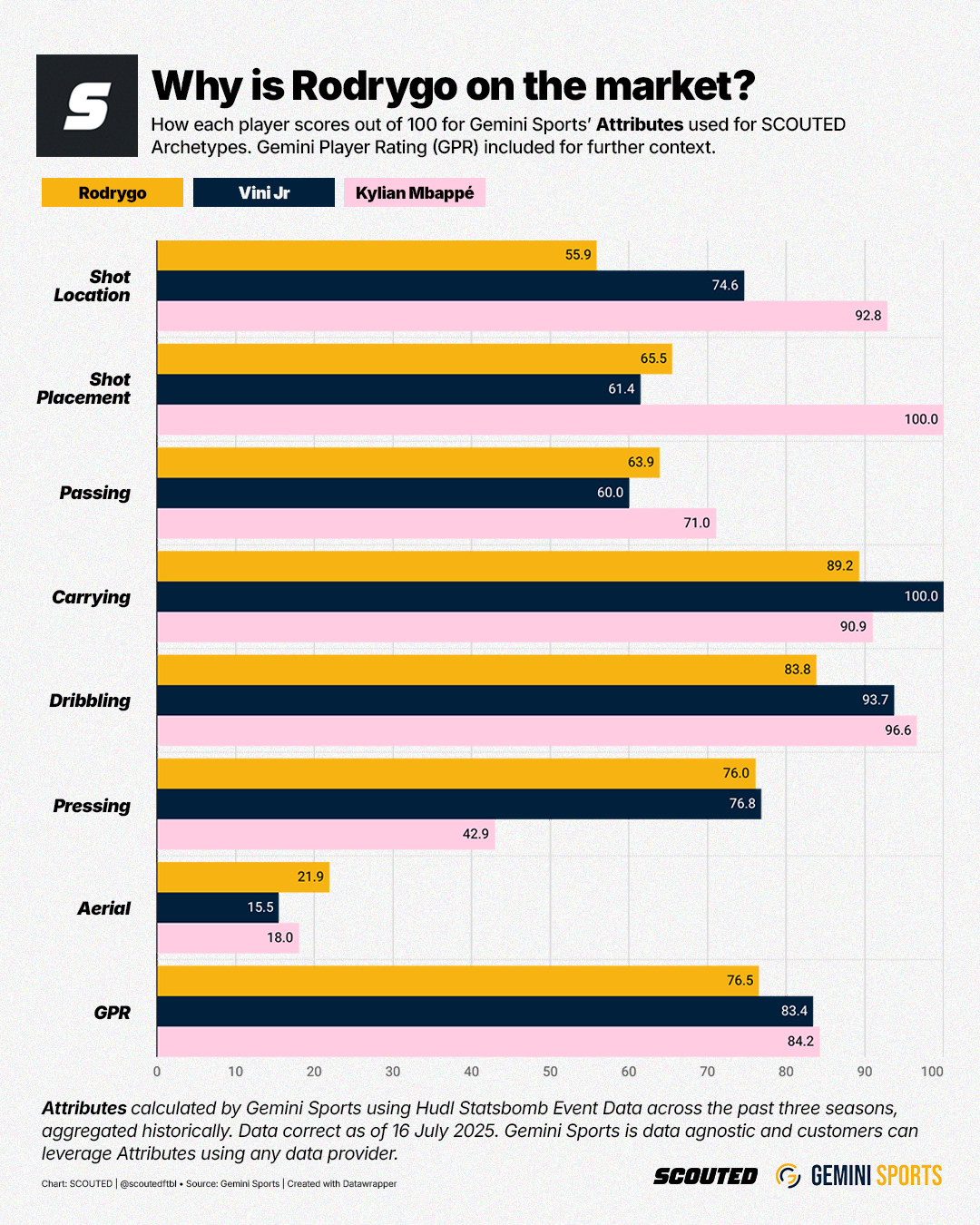
The only Attribute in which Rodrygo scores higher than both his Real Madrid teammates is the Aerial score. Perhaps due to his role as support for the two Galacticos, Rodrygo scores lower than both for Shot Location, Carrying, Dribbling and also has a lower GPR. Where he trumps Vini Jr for Shot Placement and Passing, Mbappé is ahead. Where he trumps Mbappé for Pressing, Vini Jr ranks first.
Essentially, Real Madrid have three right-footed wide forwards with shared qualities. They are all elite, but it’s difficult enough to accommodate two, let alone three. Liverpool now appear to be the favourites to take advantage of this squad imbalance, replacing the Bayern-bound Diáz with Rodrygo. On the surface, you can see why.
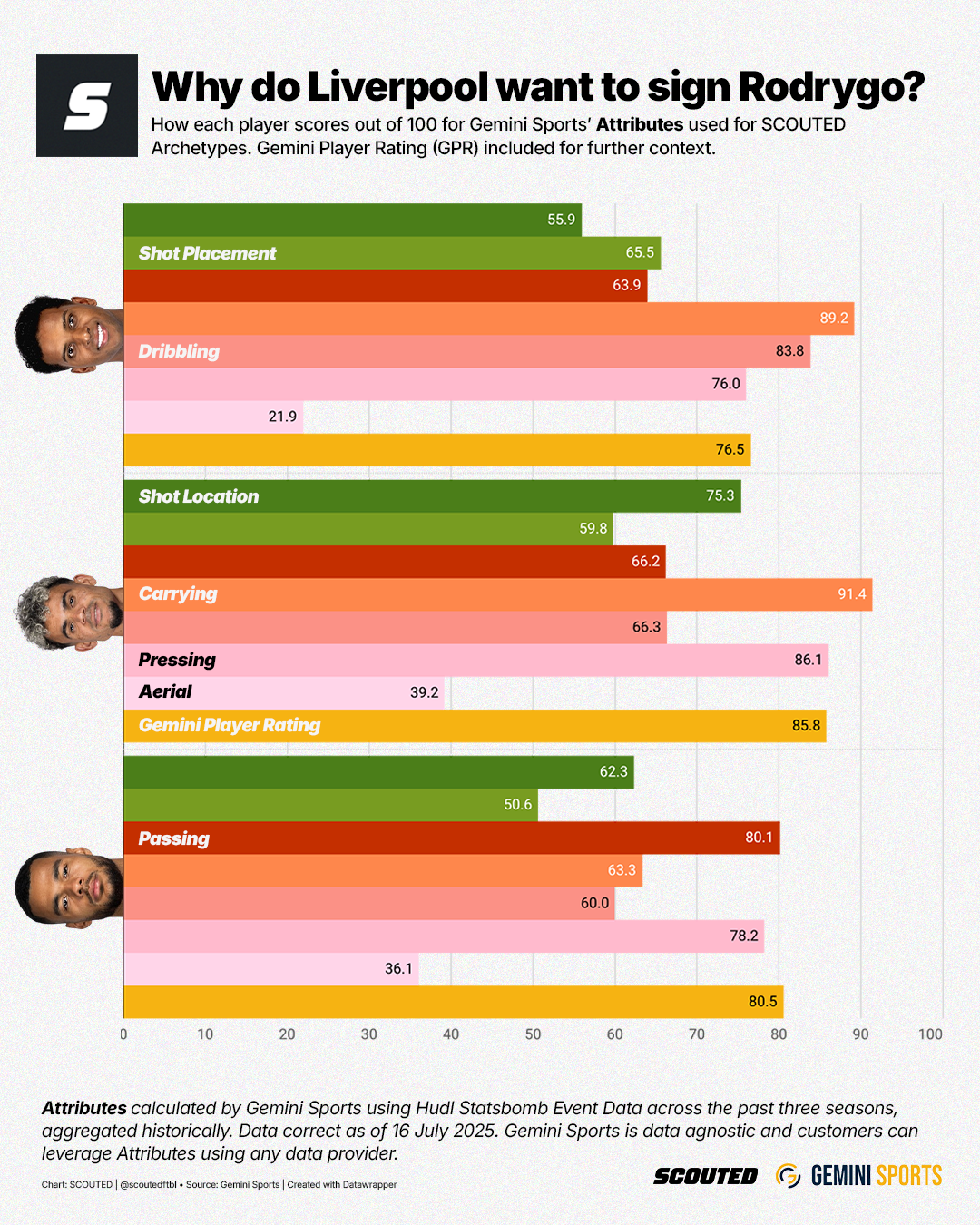
Gakpo distinguishes himself with his Passing - a trait that defined his success at PSV. But, once again, this graphic helps emphasise that Luis Díaz is really good and Liverpool should be reluctant to let him go. At the same time, at 28, it’s very smart to capitalise on Bayern’s need to upgrade their wingers and cover for Musiala’s qualities. For Arne Slot’s side, Rodrygo provides better ball-striking (Shot Placement) and Dribbling than both Díaz and Gakpo, while also matching the elite Carrying and Pressing of the Colombian.
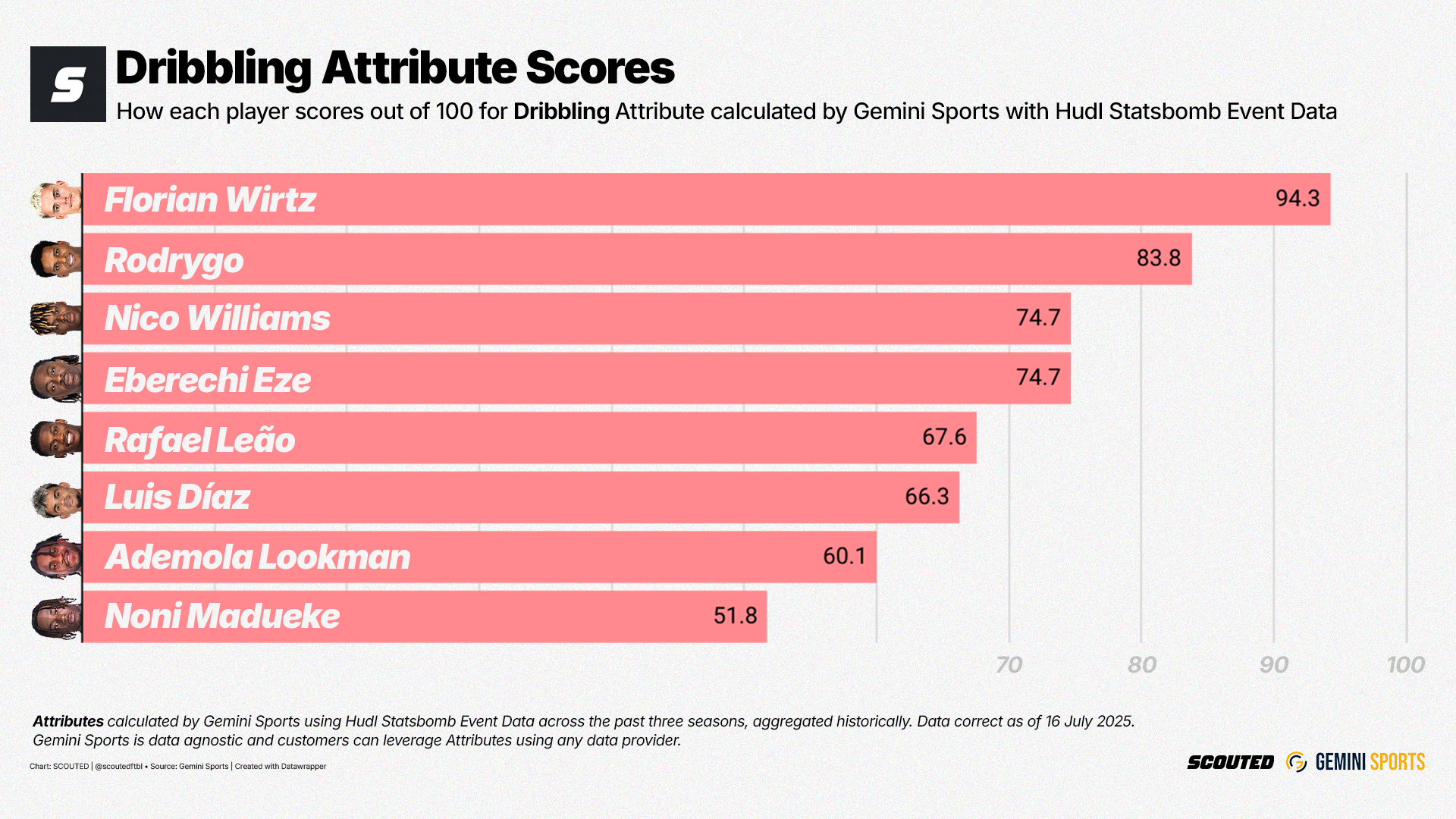
However, you may have noticed that the Brazilian’s podium Attributes of Carrying, Dribbling and Pressing are an exact match to Florian Wirtz, in name and order. Does this mean Rodrygo is moving out of the frying pan and into the fire? Does he provide enough contrast to his prospective €134m teammate to avoid getting lost in another sea of world-class talent?
Rodrygo is an elite player. But with the signing of Milos Kerkez especially, Liverpool’s left wing spot could be perfect for Wirtz to roam infield and Gameweave, with Dominik Szoboszlai providing the off-ball running in contrast to Wirtz’s ball-dominant profile. All of this is hypothetical, but you might be left wondering whether Arsenal would have been a better fit. Instead…
Why have Arsenal signed Noni Madueke?
Based on GPR, it would be very easy to argue all of the previously mentioned players would have made more sense for Arsenal than Noni Madueke. After all, he is the lowest-scoring player in our dataset at 68.4.
Here’s the crucial piece of information: Madueke is the only left-footed player in the set. Even if Mikel Arteta believes Madueke can operate from the left, as he did in the final part of the season for Chelsea, he has been signed to ensure that Arsenal can maintain a similar approach should Saka suffer another injury or, consider this, get a rest. So, why not spend an extra £20m to sign the available Bryan Mbeumo?
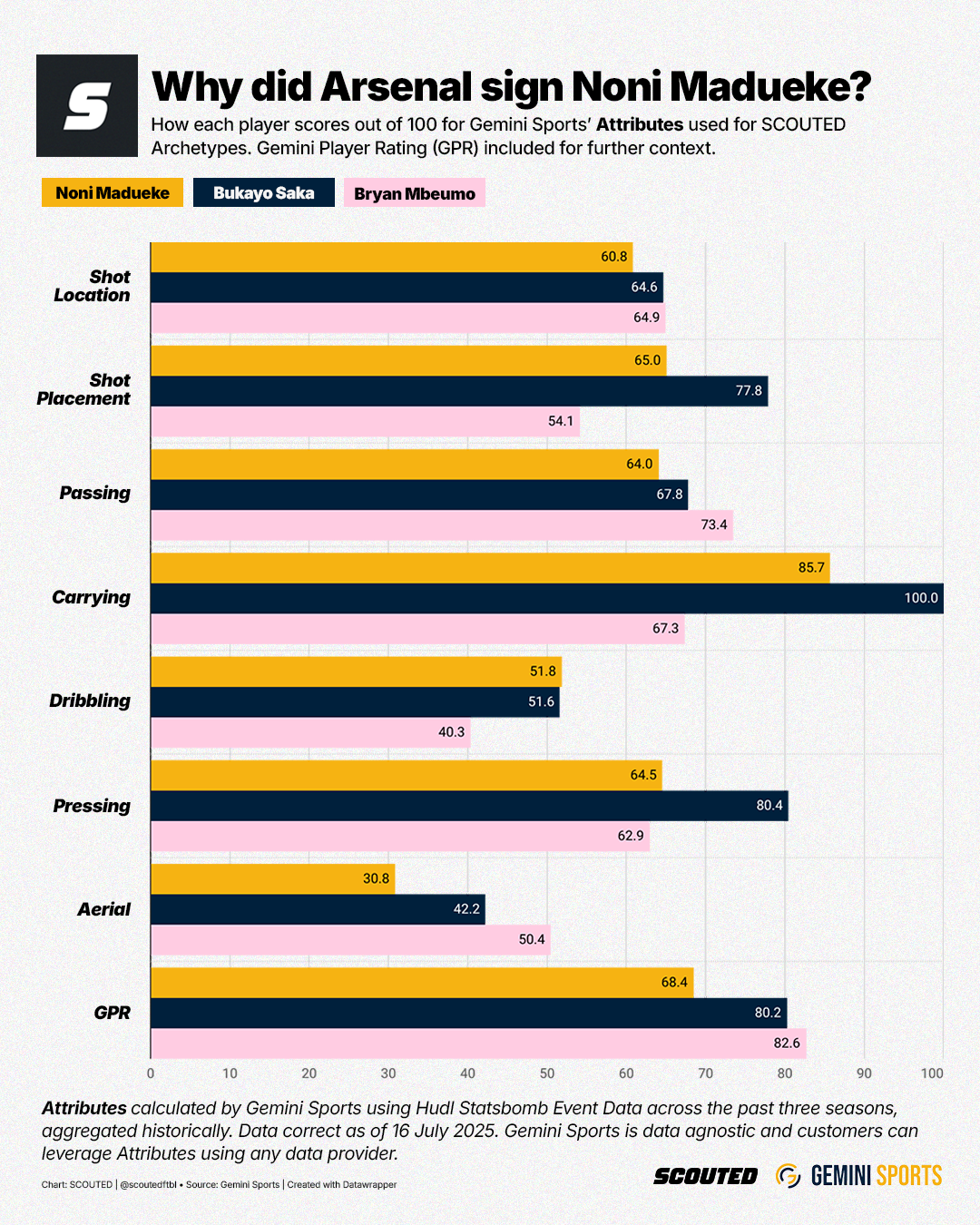
Well, despite the soon-to-be Manchester United forward attracting interest for his 20-goal haul, it’s important to remember this was his first year breaking double figures in the Premier League. Mbeumo’s superpower is, in fact, his Passing. He ranks higher than both Madueke and Bukayo Saka for this Attribute.
What Arsenal needed most in a Saka alternative, or rather in addition to Saka, was Carrying. Saka, alongside Vini Jr, represents the pinnacle of this Attribute. This is also Madueke’s superpower, echoed by my findings when exploring some simpler Event Data from FBref. While Mbeumo profiles as a Safecracker, moving towards a Gamebreaker, Madueke would very much be a Roadrunner when considering his 76.5 Physical Score. That is why Arsenal have signed him. It might also be the answer to the following question.
Why do Arsenal and Chelsea want to sign Ebere Eze?
Like Madueke, Eberechi Eze’s primary Attribute is Carrying and his secondary Attribute is Shot Placement. These appear to be two traits Arsenal have identified the current squad is lacking.
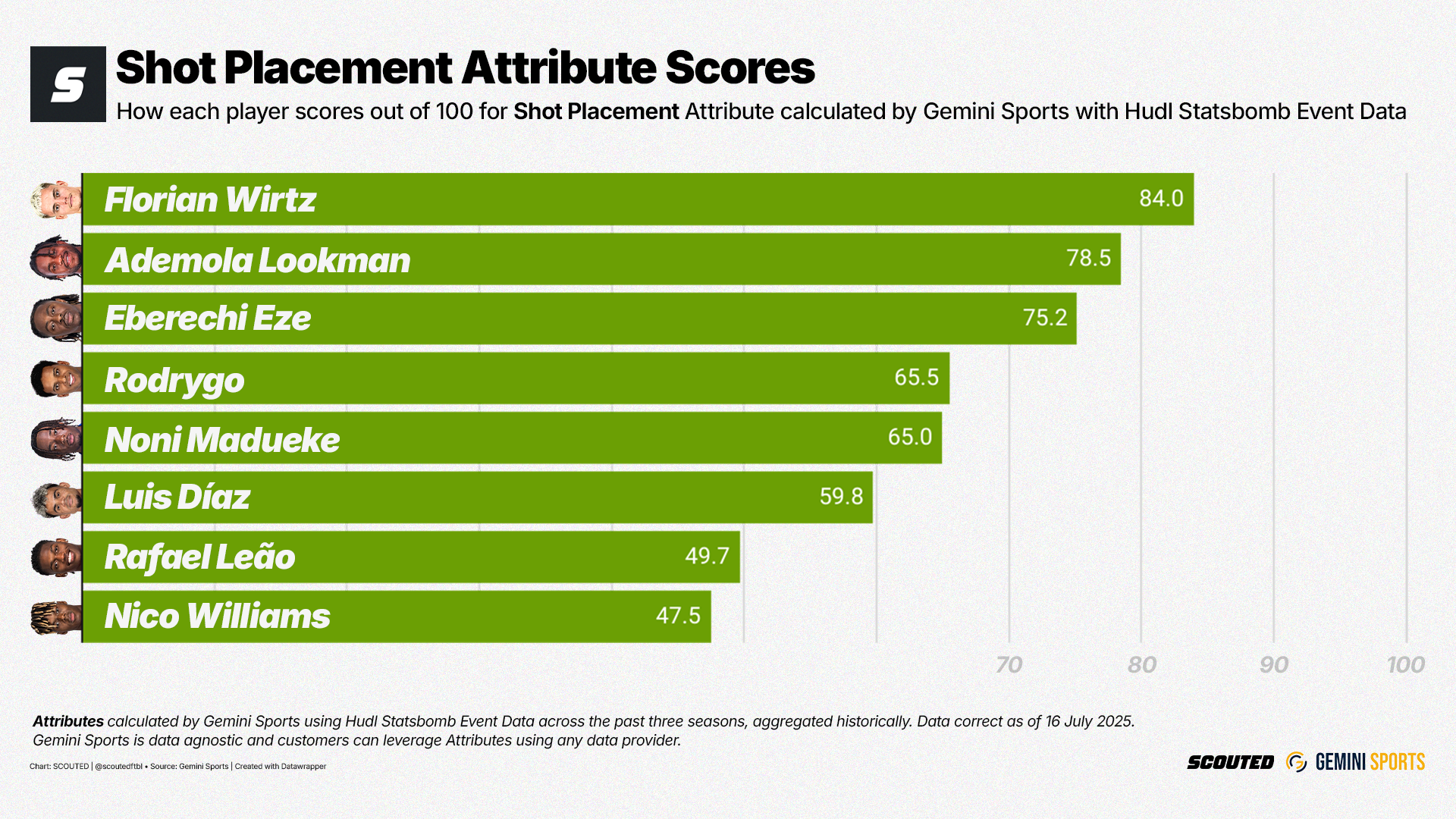
In our striker analysis, Viktor Gyökeres had the very same Attribute one-two. Coincidence? I think not.
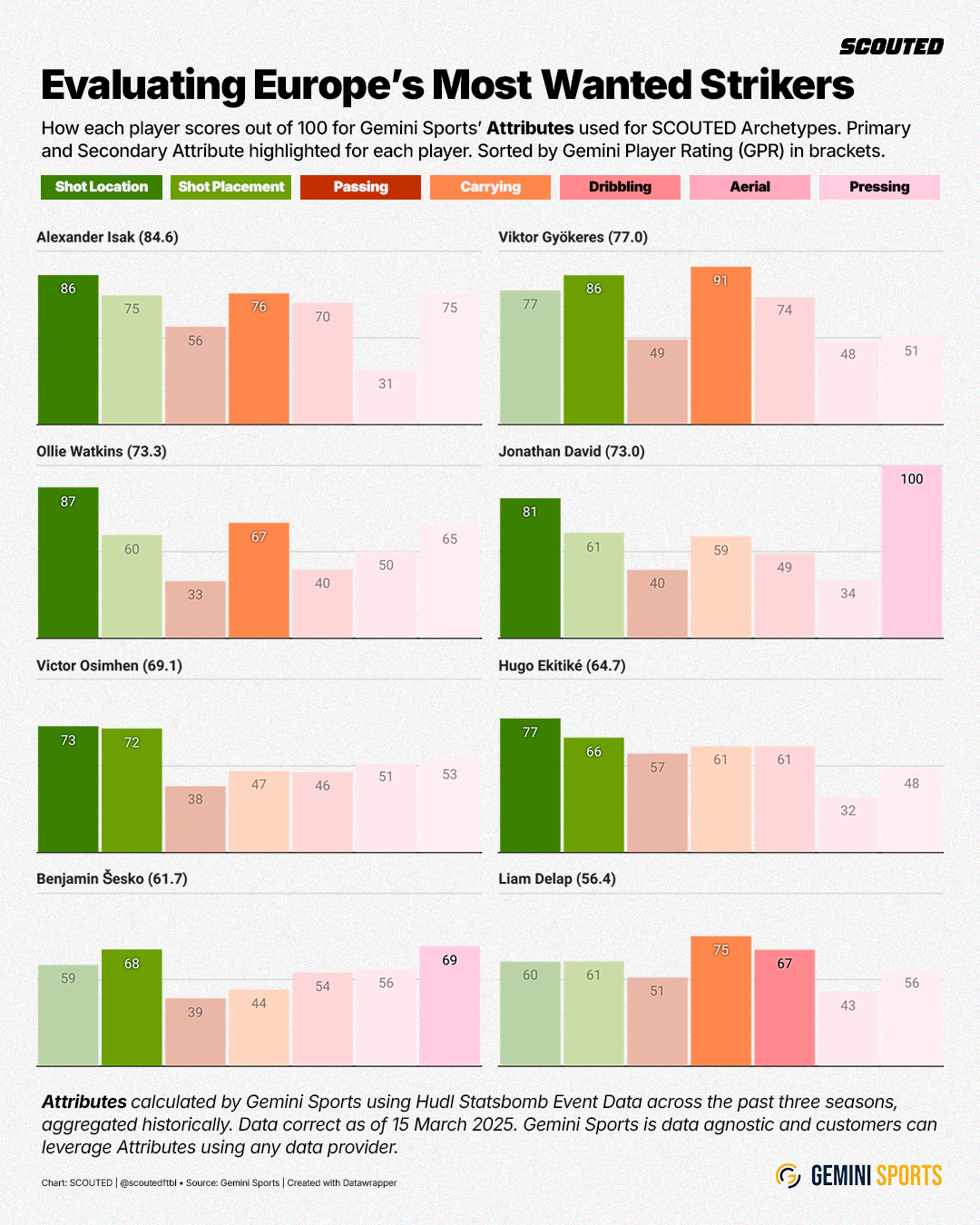
What separates Madueke and Eze is their effectiveness over large distances and in tight spaces. Madueke, with that Physical Score, is a ground-eating Roadrunner. Eze is like Wirtz, Musiala and even Rodrygo - a ballerina, drawing eyes with his Dribbling. This makes Chelsea’s interest even more confusing, considering Jamie Gittens marries both Attributes together and indexes fully into the Roadrunner profile.
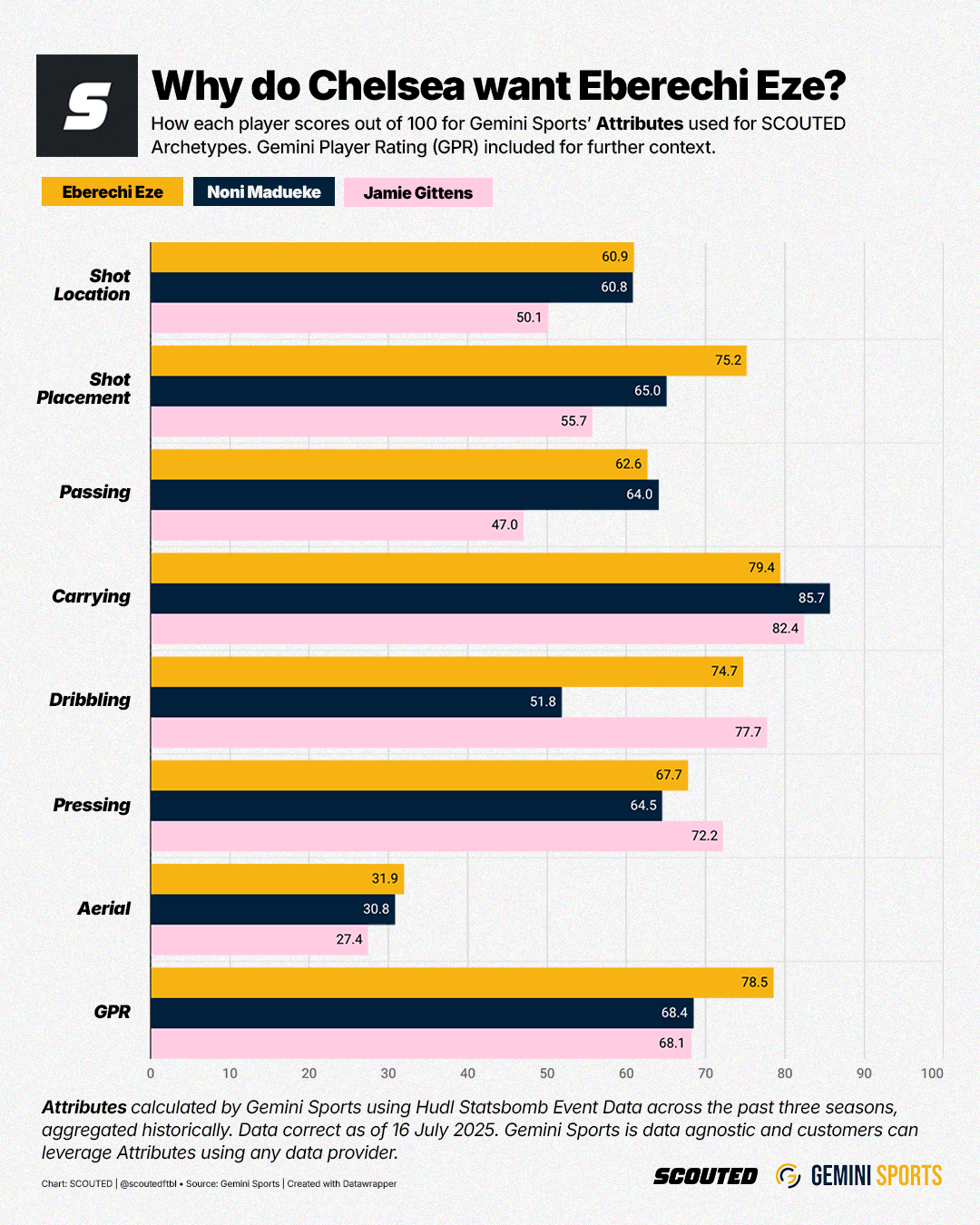
So, Chelsea have already replaced Madueke’s Carrying superpower and augmented it with Dribbling. Considering they have also signed João Pedro, I have absolutely no idea why they want Eze.
Arsenal, meanwhile, seem like they are choosing between Eze and Xavi Simons. So let’s compare those two, alongside Gabriel Martinelli. I have highlighted the Shot Placement and Carrying Attributes that Arsenal seemingly value, as well as the Dribbling that differentiates Eze from Madueke.
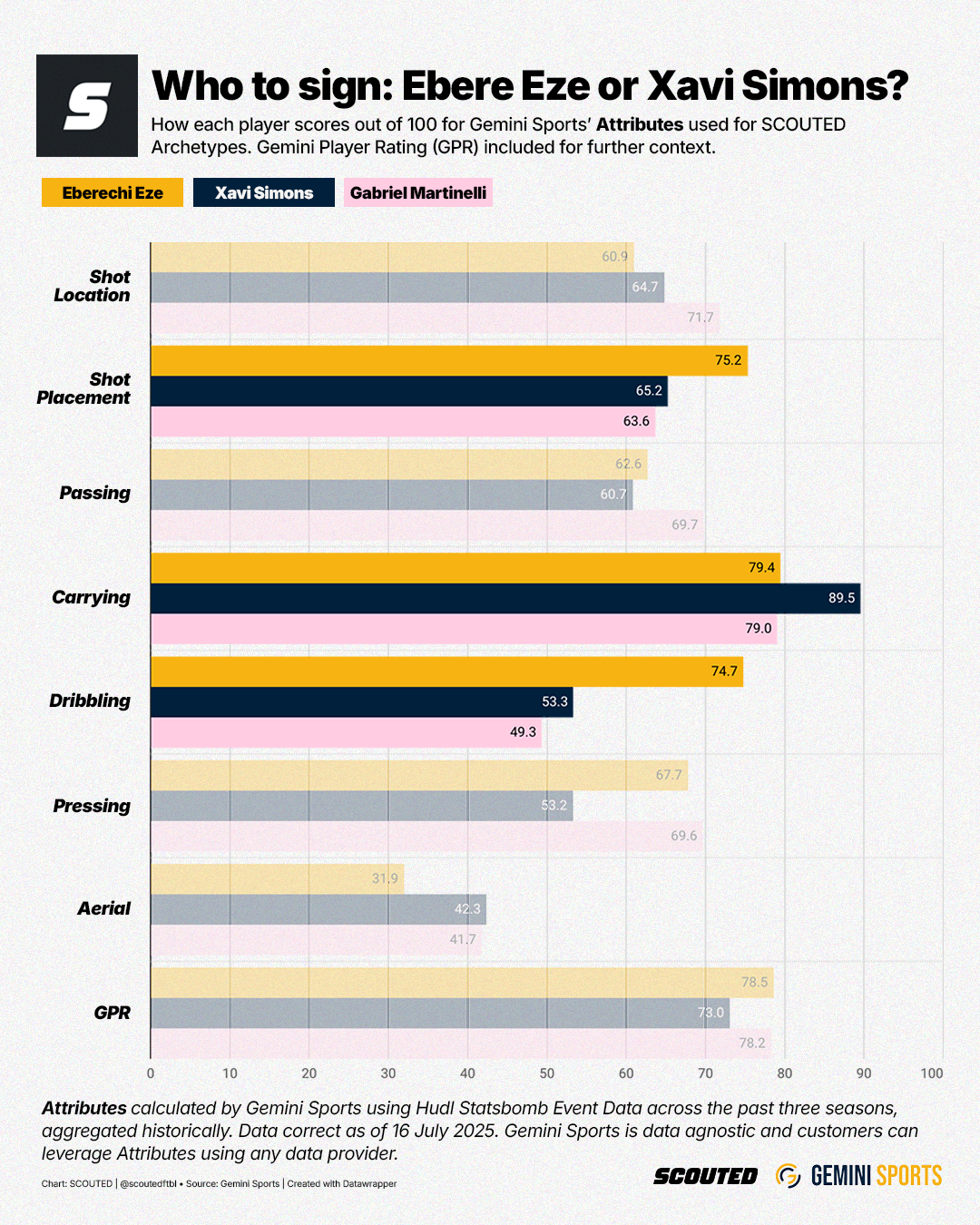
Xavi’s Carrying is elite. This, alongside his age, will probably be enough to convince most. But I feel like Madueke’s arrival has covered that area. If you scan through the rest of the Attributes, you will see Xavi and Martinelli are quite similar, whereas Eze blows both players away in Dribbling and offers better Shot Placement.
In Eze, Arsenal would be adding a self-sustaining, goal-scoring threat. Not only a player who can wriggle through tackles and into decent shooting areas, but one who can turn less favourable situations into opportunities through ball-striking. In Xavi, they would be adding a player similar to both Martinelli and Madueke. I think we have our answer.
That leaves one final question…
Why do Inter have a free run at Ademola Lookman?
Ademola Lookman may be a year older but, if reports are to be believed, he could be about to join Inter for almost half the price of Eze’s release clause. Based on the GPR - which is calculated separately for wingers and attacking midfielders, Lookman is defined as the latter - Inter could sign the third-best winger / attacking midfielder in the world right now for €40m. Why is no else submitting a bid?
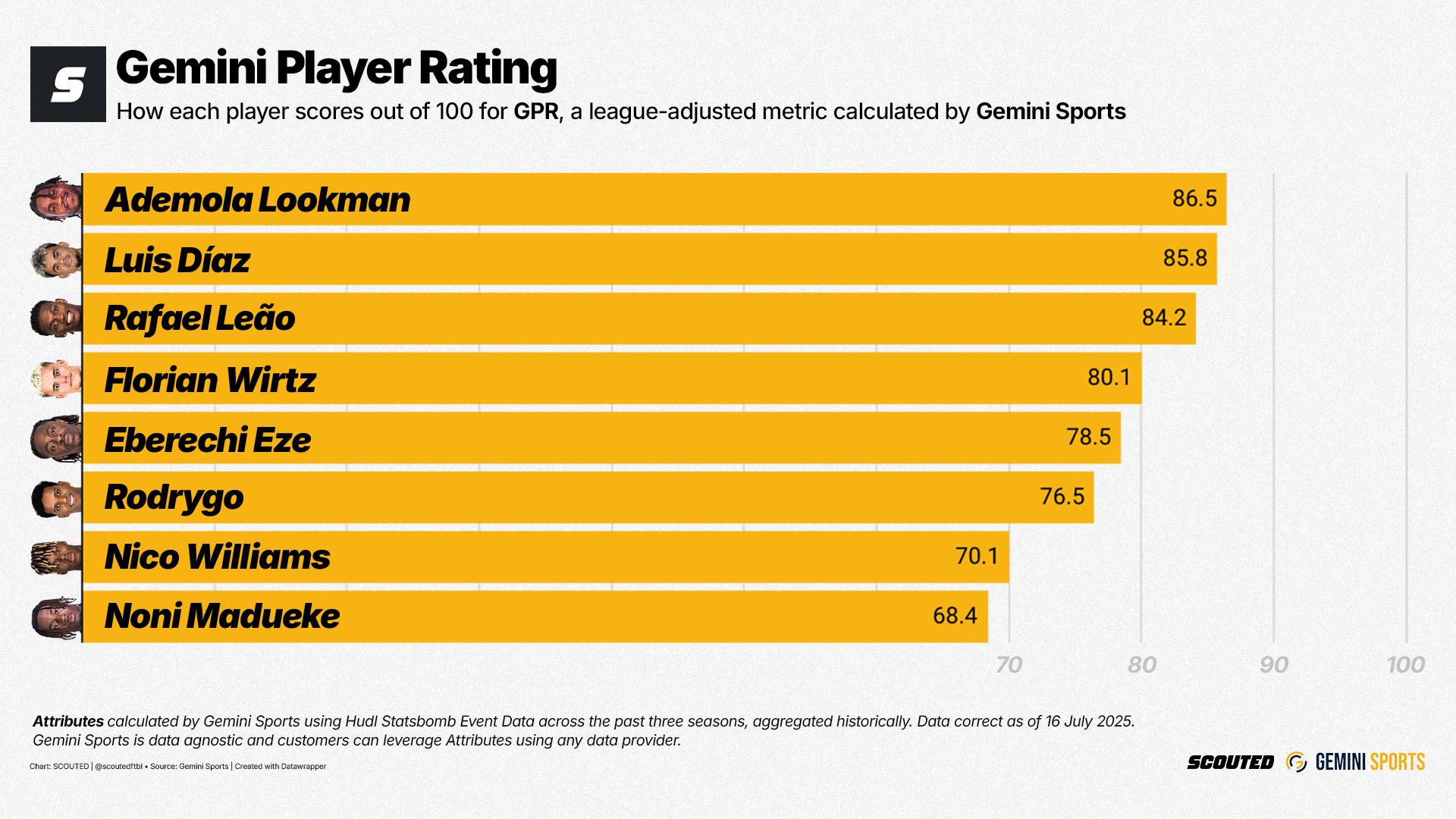
I have already addressed the age concern. Not much separates him from Eze. The next item on the list is likely to be physicality-based. And although Lookman has the second-lowest Physical Score from our selection, he ranks above Eze. So, just as we highlighted when discussing Leão, the positives far outweigh the negatives and do not seem to apply to another target. The first huge positive is the Gamebreaker Score.
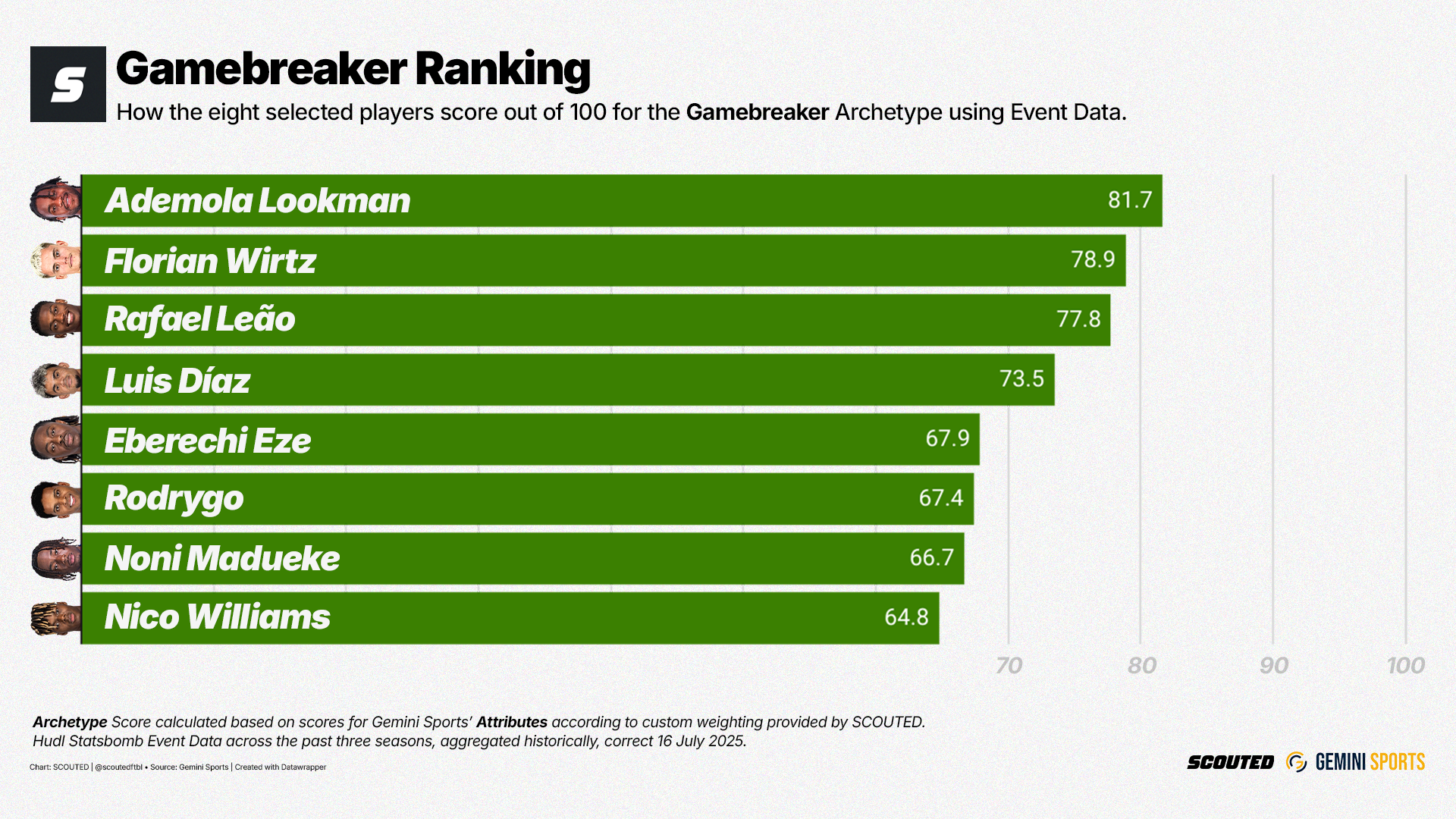
His 81.7 Archetype Score is very-much influenced by his incredible Shot Location Attribute, which is at least 10.9 more than any other player in our list. This might be influenced by the fact he plays much closer to goal than the others, but it’s still remarkable regardless.
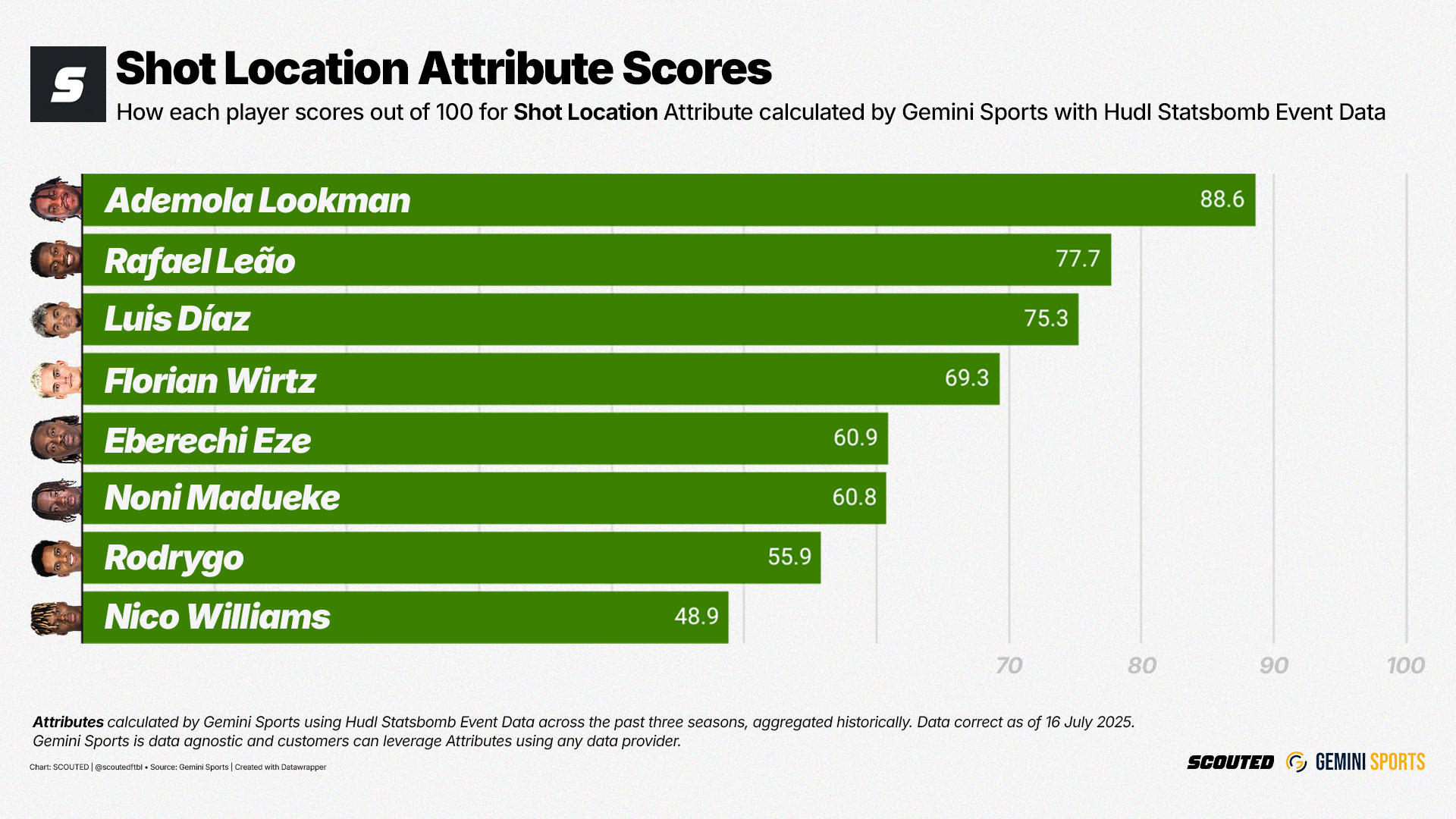
That relationship between Attribute and on-pitch role also plays into his standing as the top-rated Raider within the group; he is the only player with this Archetype as his secondary profile.
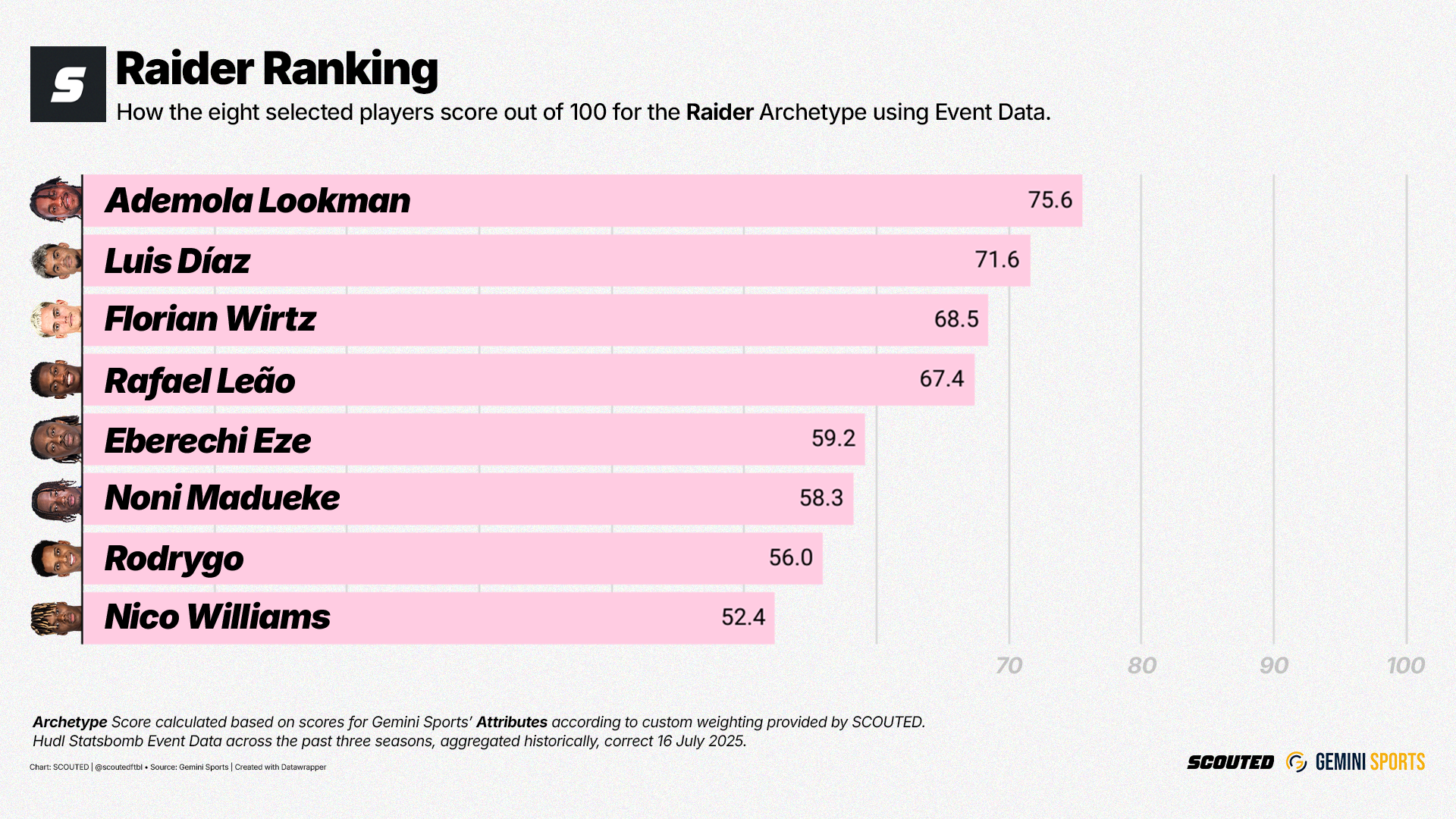
Perhaps Premier League clubs are scarred by his panenka penalty for relegation-threatened Fulham. Perhaps Eze’s Dribbling combined with his education in midfield is the reason the 2024 African Footballer of the Year has been overlooked, man.
[I’ll let you sit with that one for a moment - ed.]
All things considered, Lookman is the perfect player and profile for Inter’s 3-5-2, which looks set to continue under Cristian Chivu. At €40m, they have pulled off an incredible deal. I am just surprised other clubs did not challenge it.

Exploring SCOUTED’s Winger Archetypes through the lens of Gemini Sports Attributes has helped us understand which traits the richest clubs in the world are looking for, and the red flags they want to avoid.
The next step is the most exciting. It’s time to boot up the Gemini app in an attempt to discover a selection of the most intriguing under-the-radar under-23 alternatives to our back-page headliners.
We’ll report our findings in a future instalment of this newsletter. Stay tuned.
This article was produced under a commercial collaboration with our partners at Gemini Sports.
If you're interested in learning more about Gemini's services, you can trial the Gemini Sports App for free, for two weeks - just reach out for a call below.




